
Sew a small purse in the cutest shape everyone wants right now - a Baguette Bag! This purse may be small but you can still pack it with everything you need. It will hold your phone, wallet, sunglasses, pens, lipstick, and still have room for all those receipts we are handed. My readers asked me to write them a free sewing pattern for a baguette shaped purse - and here it is! With step by step photo instructions and downloadable templates, you will be able to sew this purse in an afternoon.
This blog post has been converted to an optional PDF that’s optimized for printing. Find it here. The Baguette Bag printable pattern templates and the instructions are included in the blog post below and are totally free to read, print, and sew! Just hit CTRL +P on your computer to print. The Optimized for Printing PDF download for $2 is totally optional.

This pretty accessory can be sewn using cotton quilting fabric, cotton canvas, home decor weight fabrics, cork, leather, vinyl, and more! I’ll share stabilizer options for making this little bag beautiful with whatever material you choose.
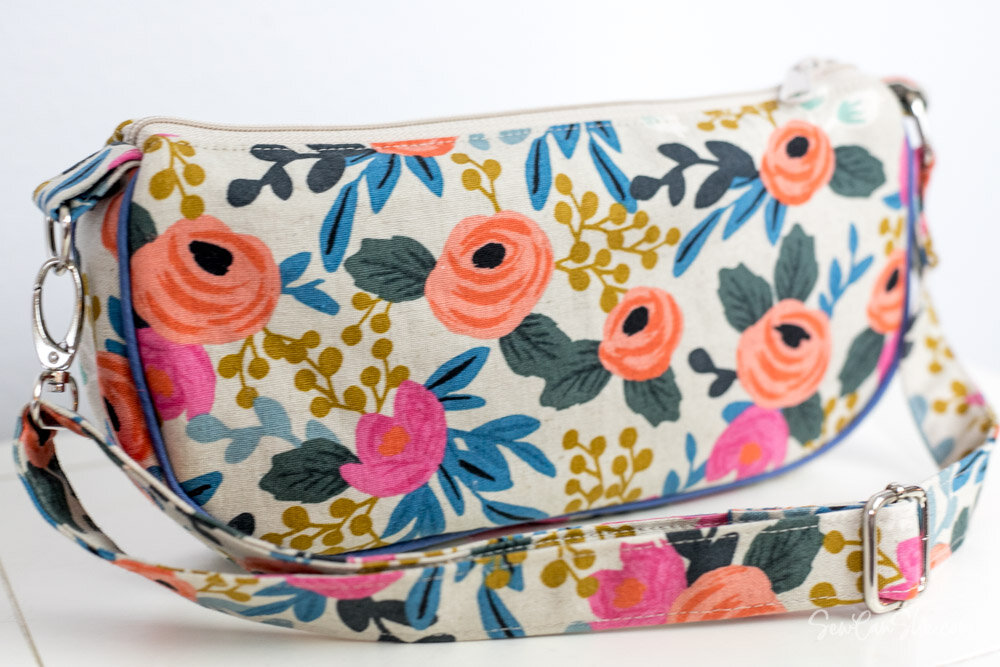
The exterior of this Baguette Bag was sewn with cotton canvas (from Rifle Paper Company). I used Wrights Maxi Piping to give the edges some extra love (don’t skip this easy step!) and I made a 1’’ wide adjustable strap.
The finished size is approximately 10 1/2’’ wide x 5’’ tall and 2’’ deep.
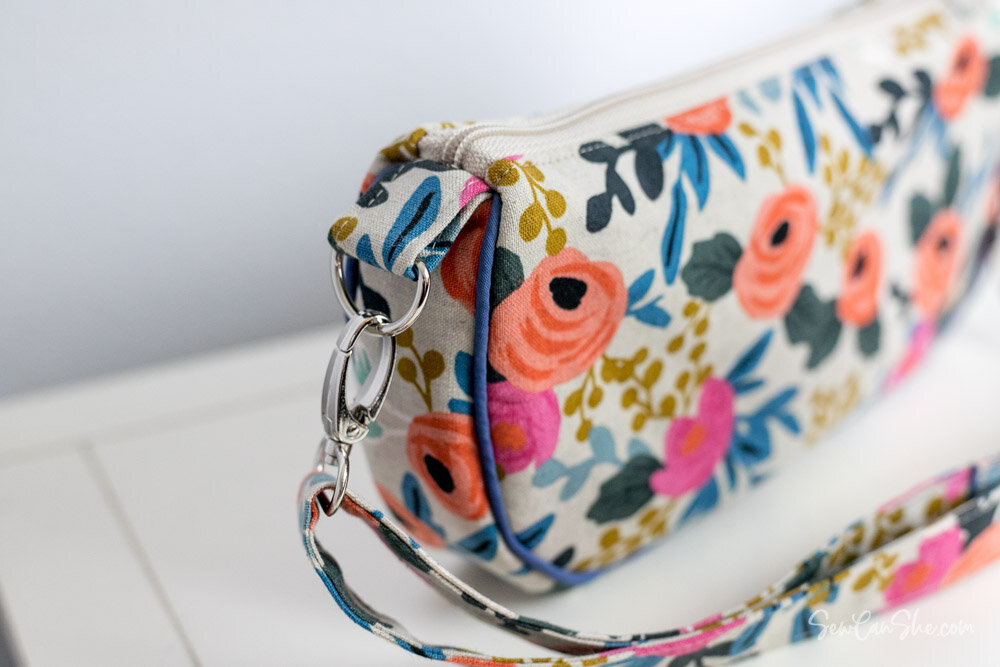
Instead of traditional interfacing, I chose to interline this bag with inexpensive craft felt. It provides a beautiful feel that doesn’t need to be quilted and doesn’t ever get the bubbles and wrinkles that can sometimes appear with fusible fleece.
This small bag would also look amazing with flexible foam stabilizer (such as Soft and Stable) quilted to your fabrics. I will share cutting instructions for sewists who are using flexible foam stabilizer.
If you love using fusible fleece, you can still use it. It would provide the same amount of body.
If you want to make this bag with a thick exterior material such as vinyl, leather, cork, or very heavy fabric, the felt interlining can be optional.
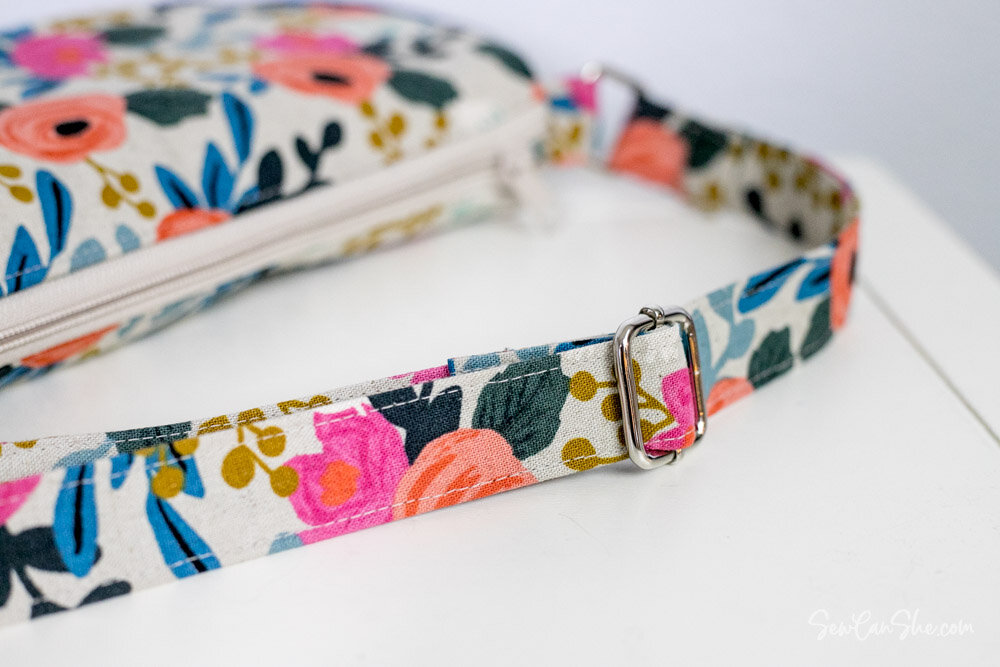
The zipper technique that I use is demonstrated in video Lesson 2 of my Designer Zipper Bags Video Course. I totally recommend that you sign up and watch it for free! In addition, the binding technique is shown in Lesson 3.
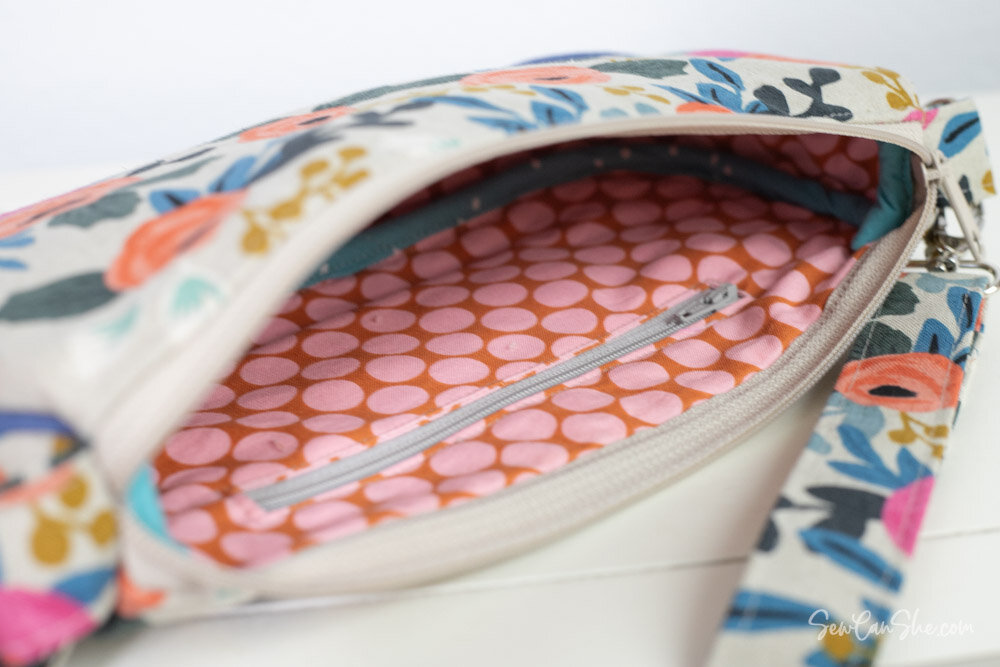
The interior of the Baguette Bag has a Welt Zipper Pocket on one side and a credit card sized patch pocket on the other side.
Are you ready? Let’s sew a Baguette Bag small purse!
You will need:
-
1/2 yard of fabric for the bag exterior and strap. Suggested fabrics:
quilting cotton fabric
cotton canvas
cotton/linen blend fabrics
cork fabric
leather
faux leather or vinyl
laminated fabric
home decor fabric
-
1/4 yard of fabric for the bag interior and optional pockets. Suggested fabrics:
quilting cotton fabric
lightweight cotton or polyester blend fabrics
1/4 yard cotton fabric for binding the interior seams (a fat quarter will work best, see Cutting below)
1/4 yard of acrylic craft felt (white or another neutral color)
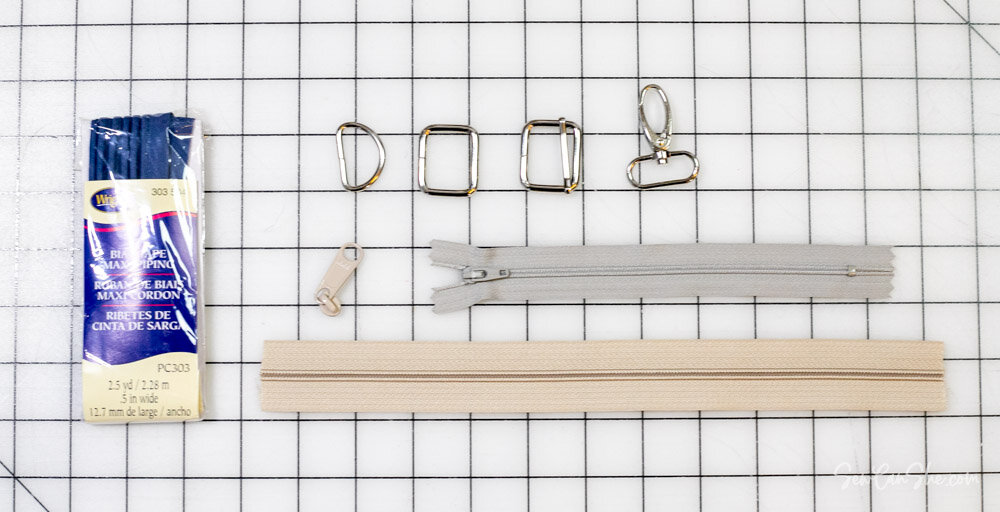
1 1/4 yards of Wrights Maxi Piping
a 12’’ long YKK size 4.5 handbag zipper or ByAnnie Zipper By the Yard
a 6’’ or longer zipper for the interior welt zipper pocket - I used regular dressmaking zipper for my interior pocket, but a wide handbag zipper would be fine too.
1 metal d-ring, size 1’’
1 swivel snap clip with a 1’’ opening
1 triglide slide, size 1’’
Quilt basting spray, such as SpraynBond
pencil or fabric marking pen
Sewing stiletto (very helpful for the binding!)
a heavy duty needle, such as my favorite Superior Titanium Coated Topstitch needle, size 100/16
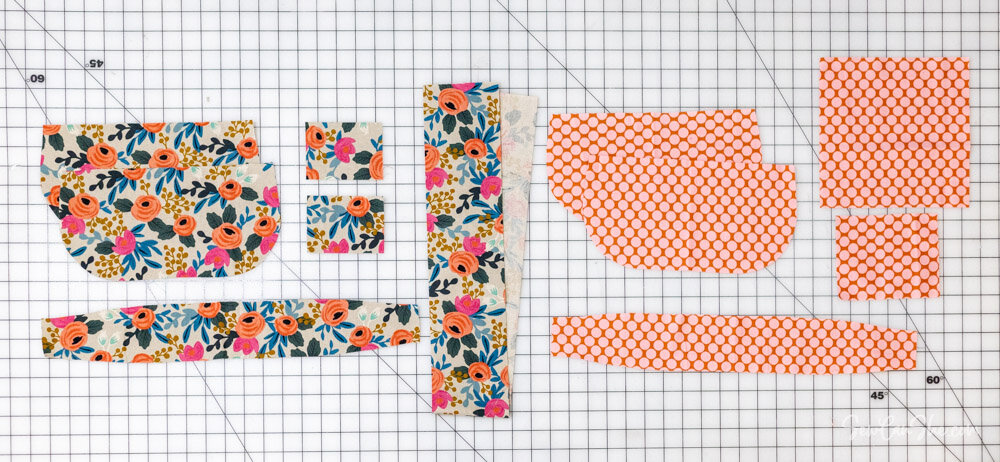
Cutting
Download the free Baguette Bag pattern templates here.
From your fabric for the purse exterior, cut:
2 pieces on the fold using the bag side template
1 piece on the fold using the bag gusset template
2 rectangles 3’’ x 4’’ for the ring tabs
1 rectangle 4’’ x 35’’ for the strap
From your fabric for the purse interior (lining), cut:
2 pieces on the fold using the bag side template
1 piece on the fold using the bag gusset template
1 rectangle 5 1/2’’ x 4 1/2’’ for the card pocket
1 square 8’’ x 8’’ for the welt zipper pocket
From the binding fabric, cut:
2 bias cut strips 2 1/2’’ x 20’’*
2 strips 2 1/2’’ x 3 1/2’’ (may be bias cut if desired)
*Note: If your fabric does not allow you to cut 20’’ long strips on the bias, you can sew strips together to make two 20’’ long pieces of bias binding. It is recommended that the 20’’ long binding pieces be cut on the bias because they has to be sewn around curved edges. See my clever bias binding tutorial from a fat quarter. It makes more than you need so you’ll have extra!
From the acrylic craft felt, cut:
2 pieces on the fold using the bag side template
1 piece on the fold using the bag gusset template
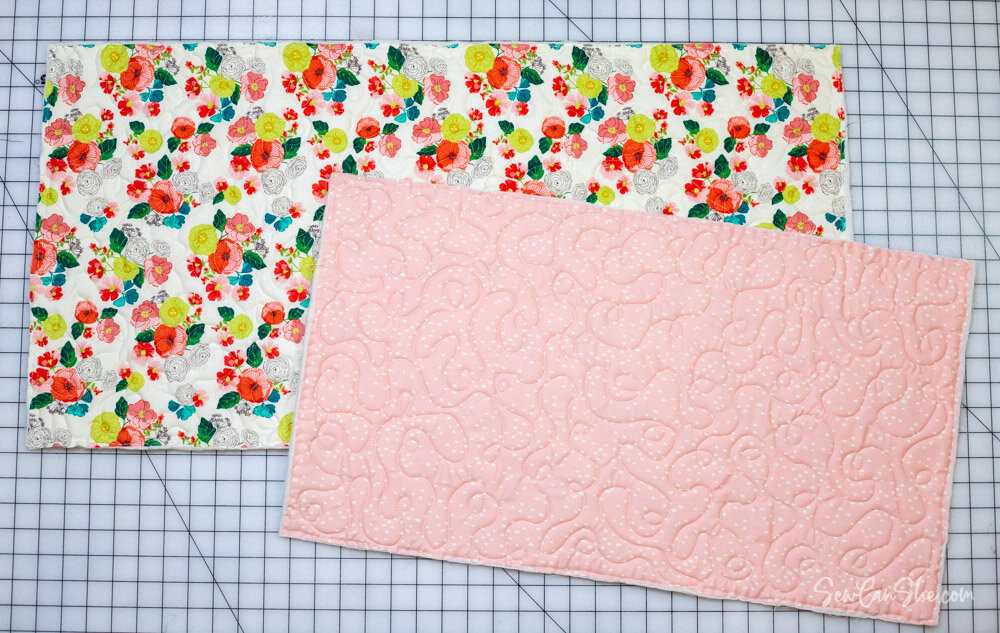
These pieces are only an example. They are not the same size that you will need to make.
Optional Instructions if you would rather use flexible foam stabilizer and quilting cotton:
Watch my video on YouTube about quilting cotton fabric and foam stabilizer together.
1. Cut a 21’’ x 4’’ piece of exterior fabric, lining fabric, and flexible foam stabilizer. Baste and quilt these 3 pieces together using the technique shown in the video linked above. Use this quilted piece to cut out your bag gusset using the bag gusset template.
2. Cut a 14’’ x 14’’ square of exterior fabric and flexible foam stabilizer. Baste and quilt these 2 pieces together using the technique shown in the video linked above. Do not attach a lining to this piece unless you do not want interior pockets. Use this quilted piece to cut out your exterior bag side pieces using the bag side template. Cut your lining side pieces from fabric without stabilizer so you can attach pockets.
If you are using fabric that has been quilted to the stabilizer, you can skip the first step below for basting craft felt to the fabric.
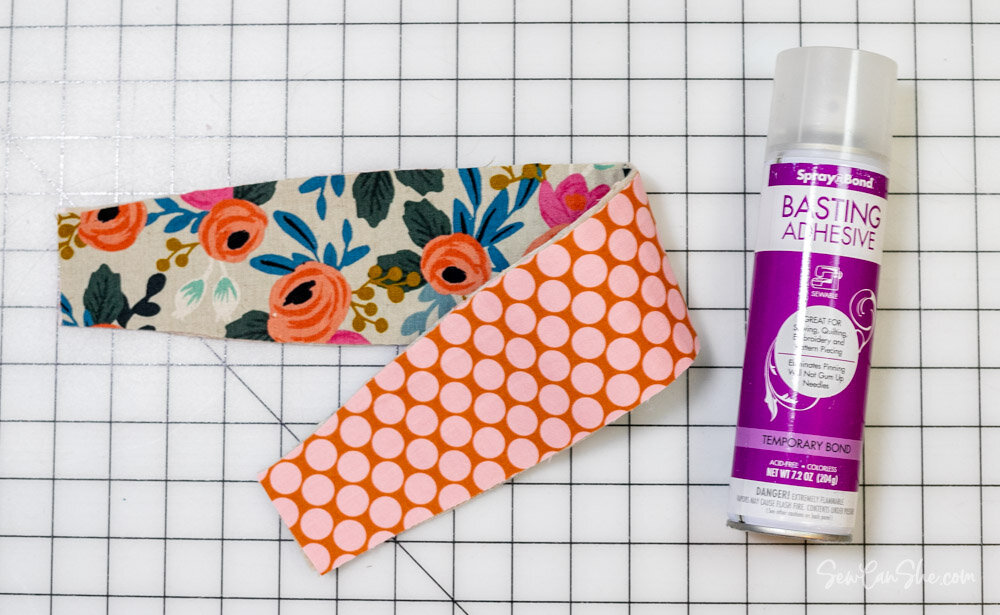
Begin: Make the Gusset
1. Use the basting spray to adhere the exterior gusset piece to one side of the felt gusset piece. Then adhere the gusset lining to the other side of the felt piece.
You will have a ‘sandwich’ of exterior fabric, felt, and lining, all stuck together.
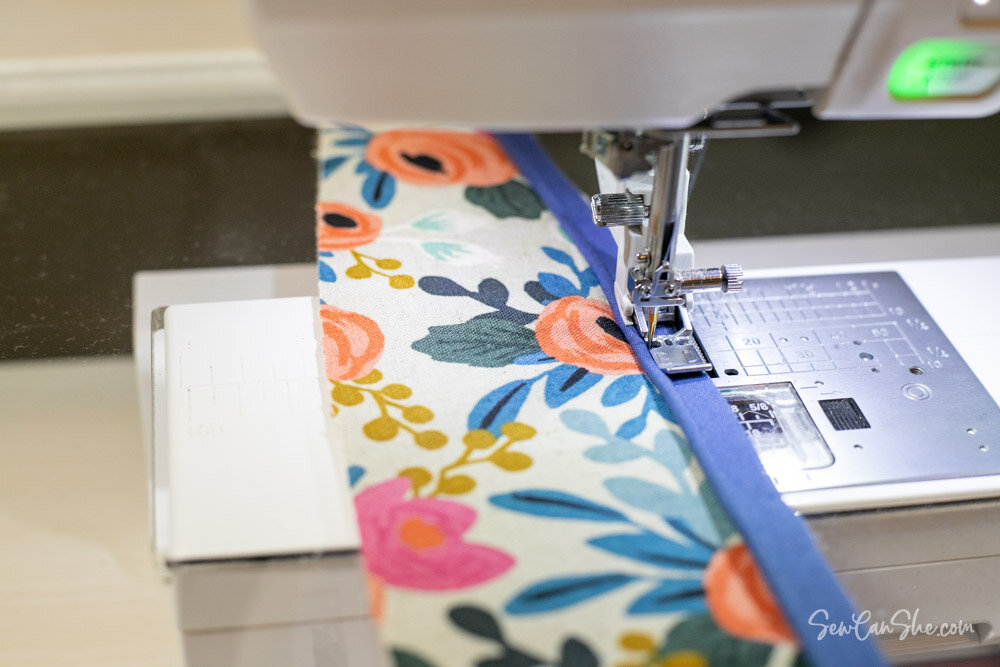
2. Cut two pieces of maxi piping that are 20’’ long. Sew one piece to each long edge of the gusset.
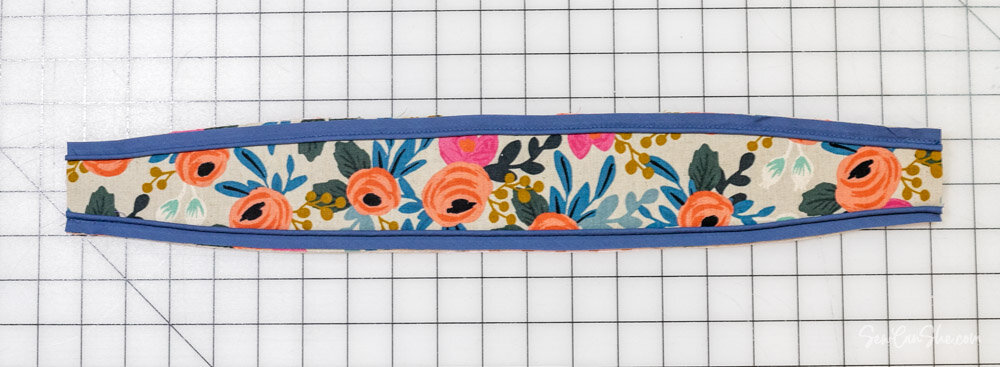
Tips:
For best results, sew on top of the line of the stitching that is on the piping.
Use your zipper foot so you can sew as close to the piping as possible.
This makes a 3/8’’ seam allowance.

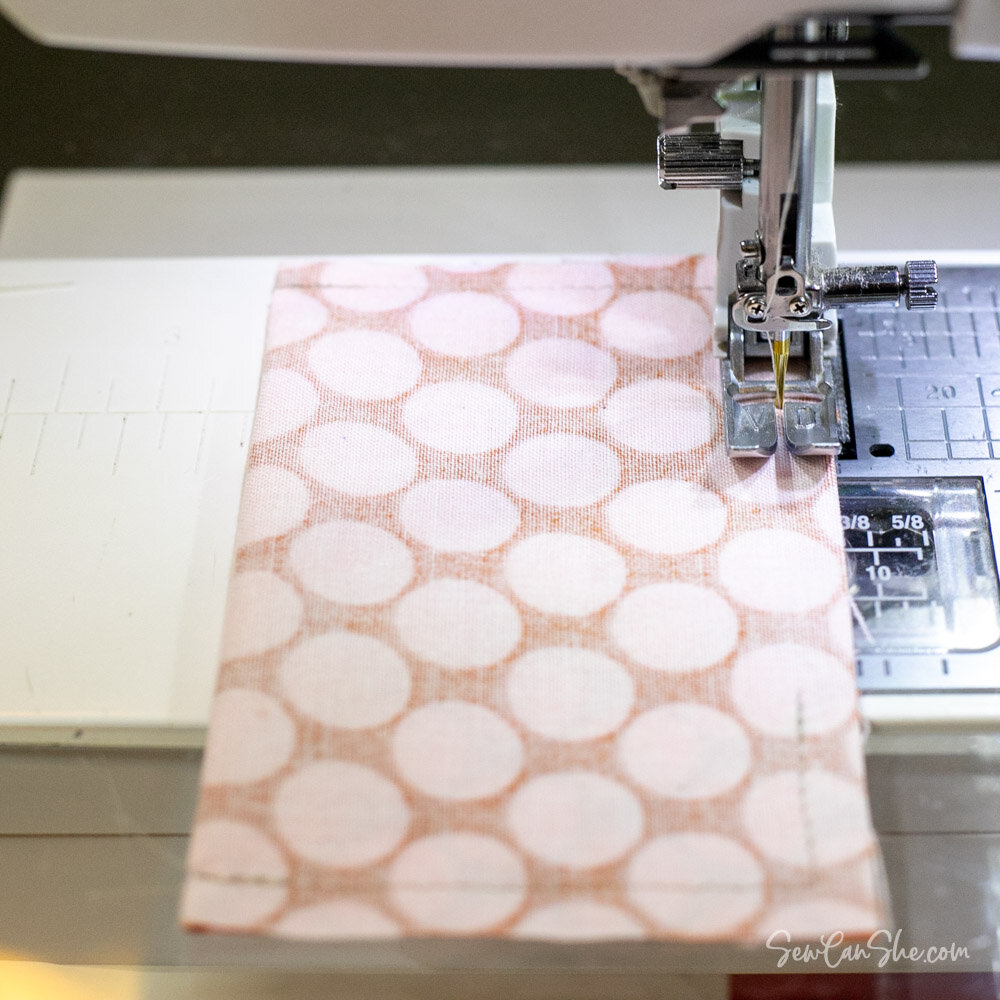
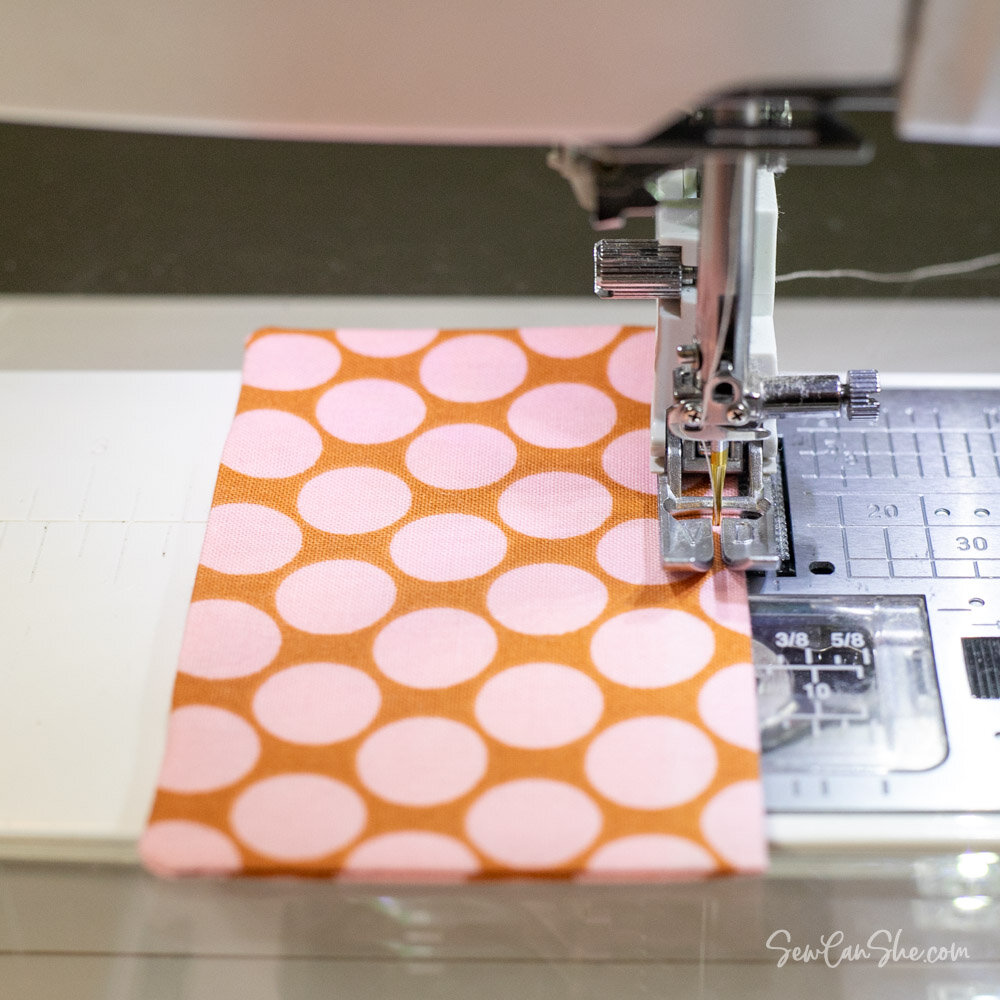
Make the Card Pocket
1. Fold the 5 1/2’’ x 4 1/2’’ pocket rectangle in half with the 4 1/2’’ edges together.
2. Sew around the edges with a 1/4’’ seam allowance, leaving a 2’’ opening for turning. Turn the pocket right side out through the opening. Turn the raw edges to the inside and press the pocket flat.
3. Topstitch 1/8’’ away from one of the longer edges. This will be the top edge of the pocket.
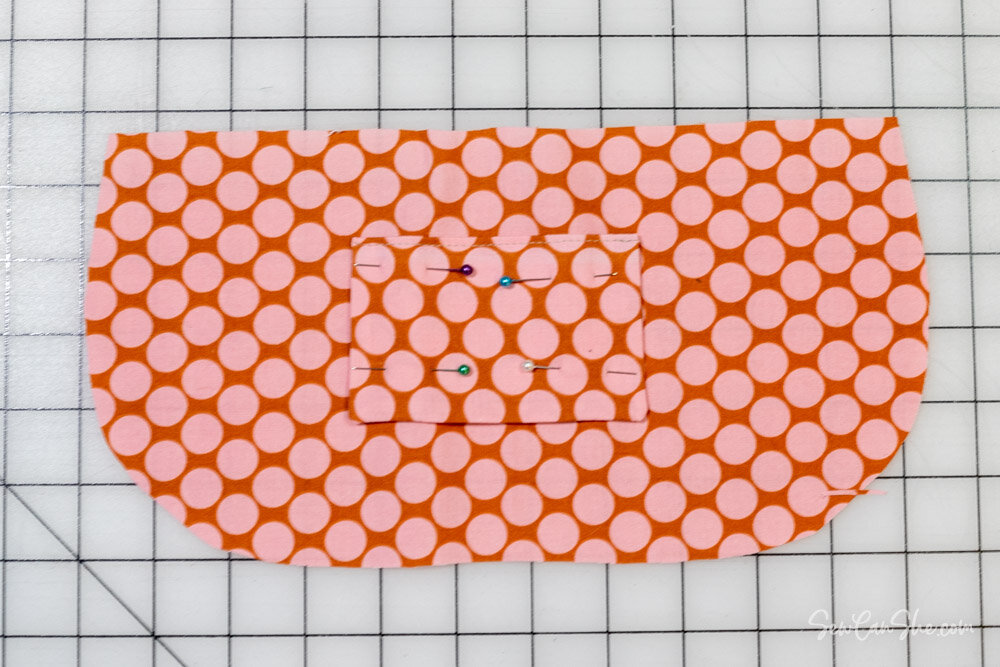
4. Pin the card pocket to one of the lining pieces. It should be centered and 1 1/2’’ below the top straight edge.
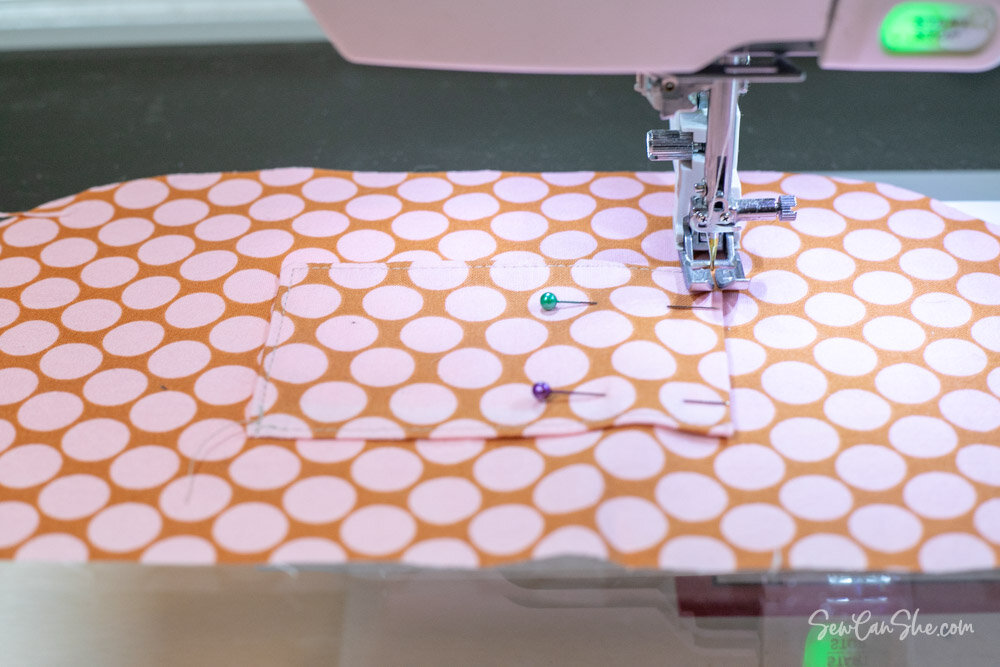
5. Sew around the pocket 1/8’’ away from the the side and bottom edges to attach the card pocket. Make sure to topstitch at the top corners to secure the pocket.
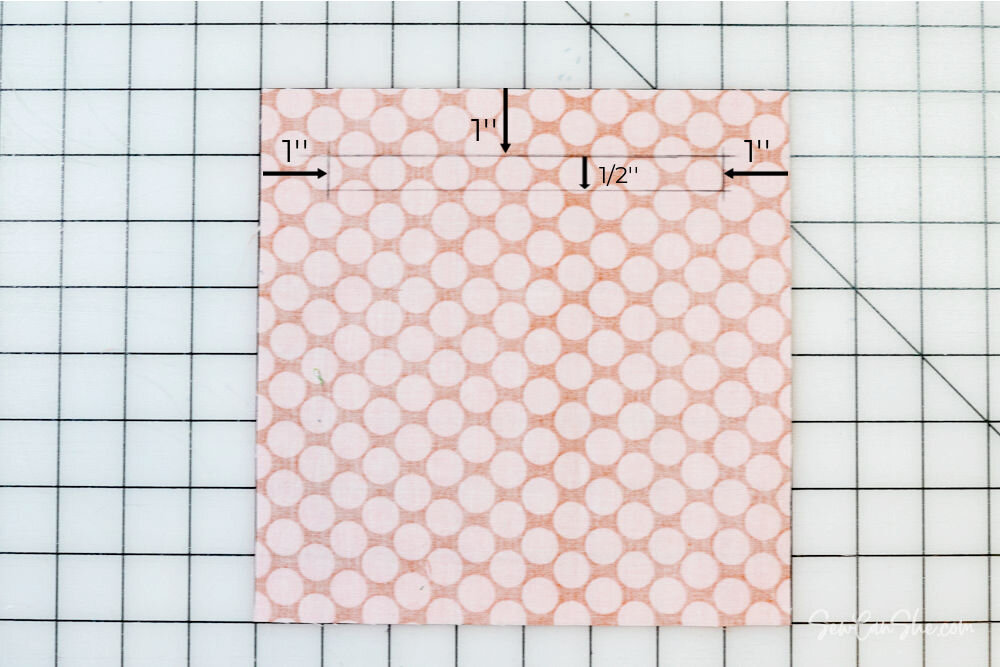
Make the Welt Zipper Pocket
Also see my Welt Zipper Pocket tutorial.
1. On the wrong side of the 8’’ zipper pocket square, use a pencil or fabric marker to draw a horizontal line 1'' below the top edge. Draw another line 1/2'' below that first line.
Then connect the two long lines with short vertical lines 1'' from each edge. You should have a long skinny rectangle 1/2'' tall and 6'' long.
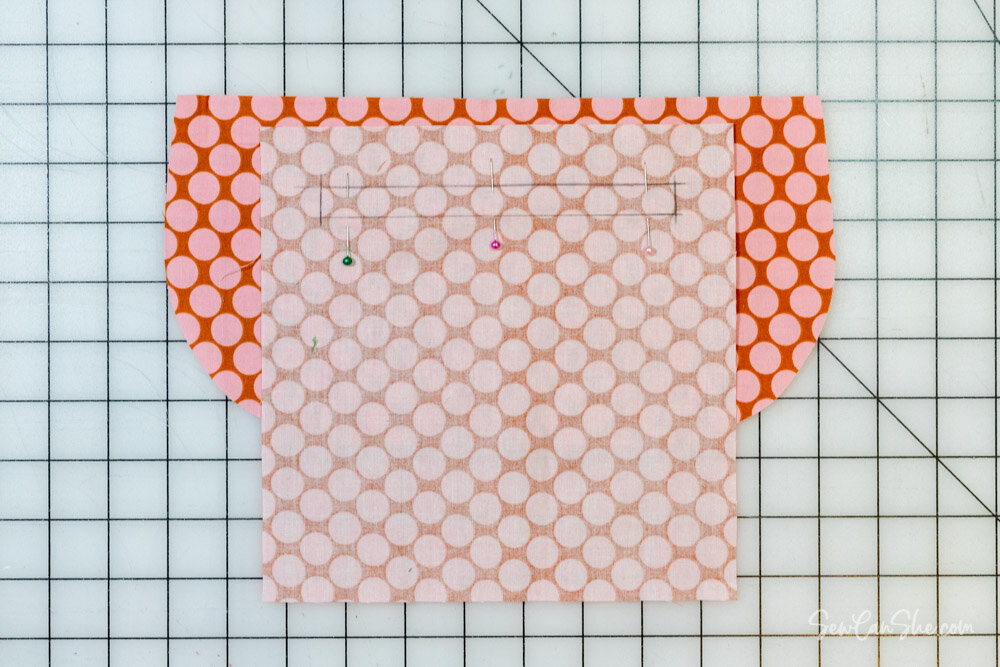
2. Place the pocket square on top of the remaining bag lining piece, right sides together. The pocket square should be centered and 1/2’’ below the top edge of the lining piece. Pin the two pieces together.
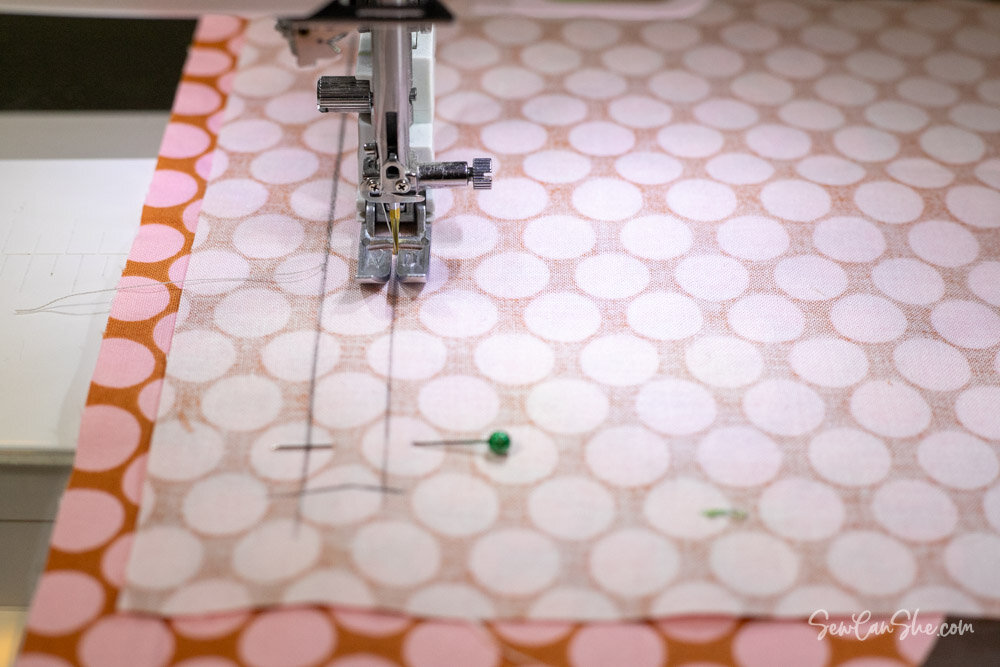
3. Sew on top of rectangle that you drew, trying to be as precise as possible.
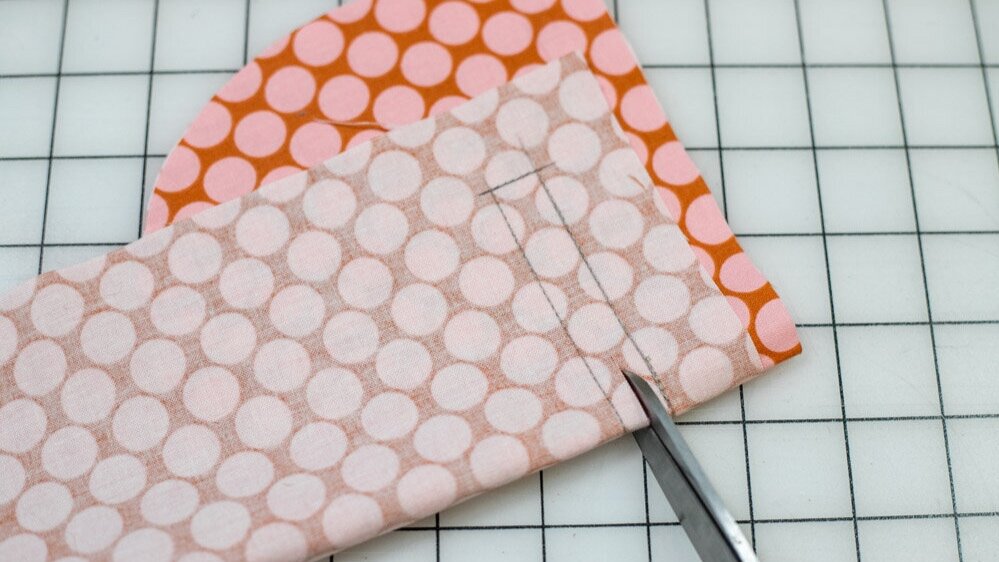
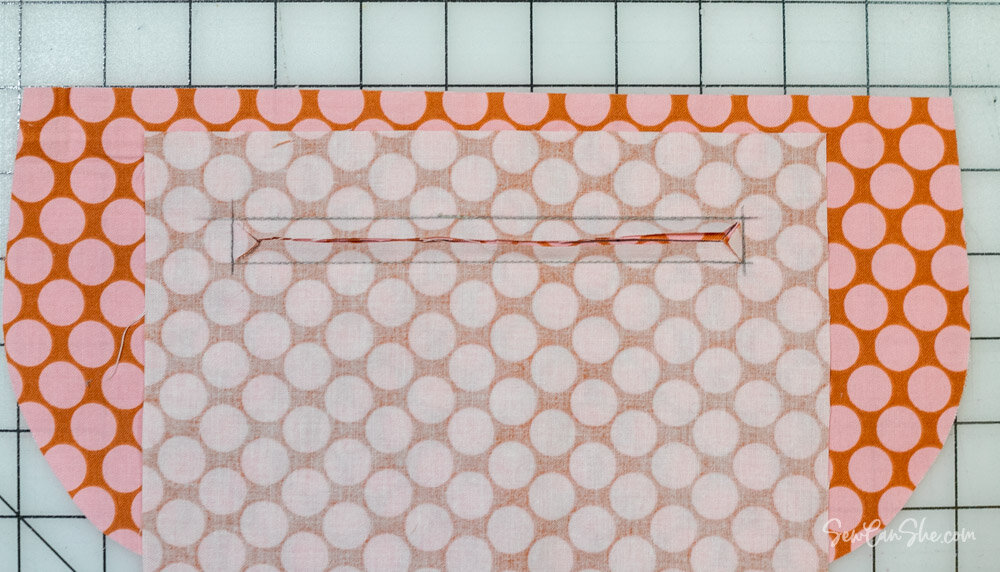
4. Use sharp scissors to cut a long slit down the center of the rectangle to within 1/4’’ of each short end. Then clip to the corners. Be careful not to cut the stitching.
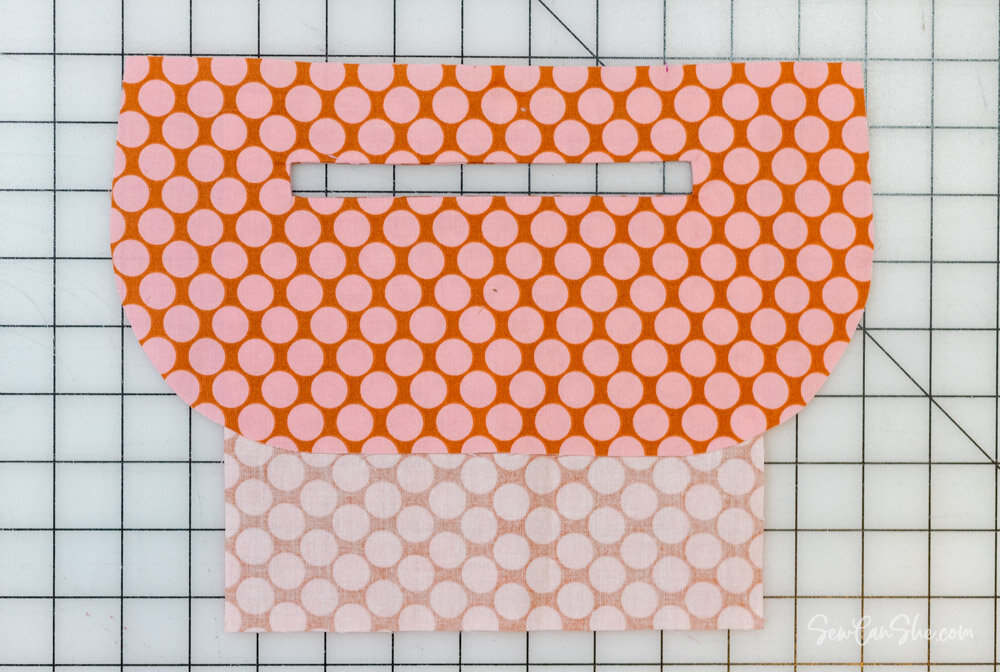
5. Turn the pocket piece through to the back of the bag lining piece. Press gently from both sides.
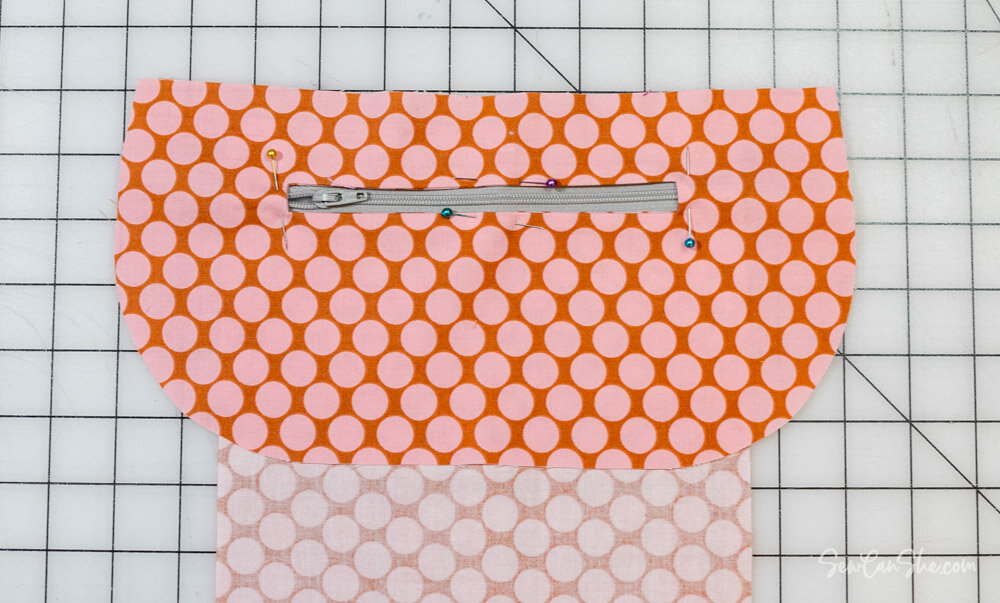
6. Center the zipper under the opening and pin around the edges to secure it. Make sure the slider is visible in the opening.
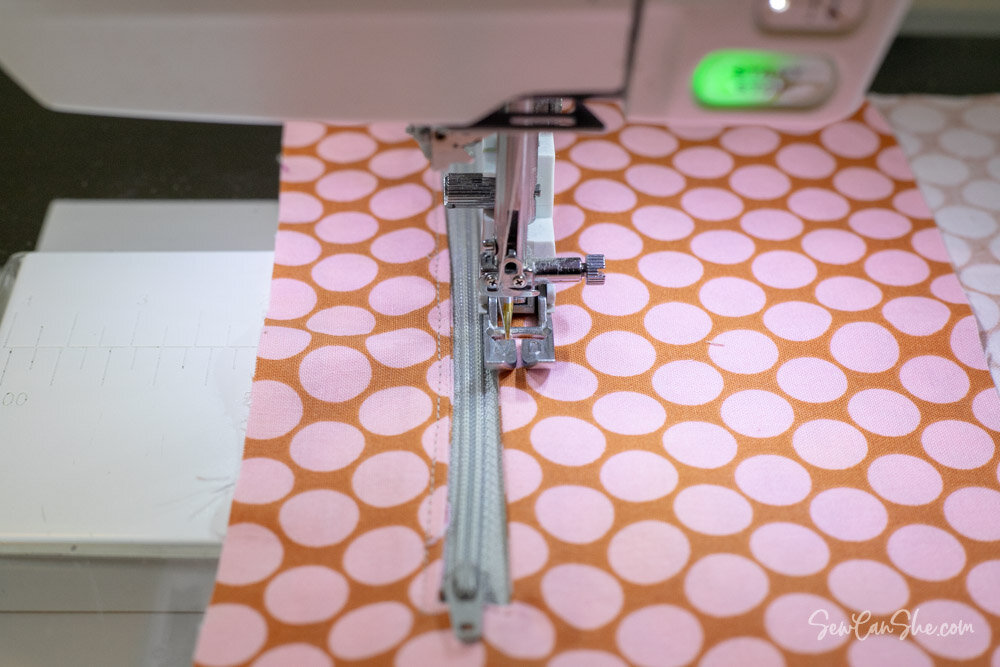
7. Topstitch around the zipper opening, 1/8'' from the edge. Use a zipper foot if it helps.
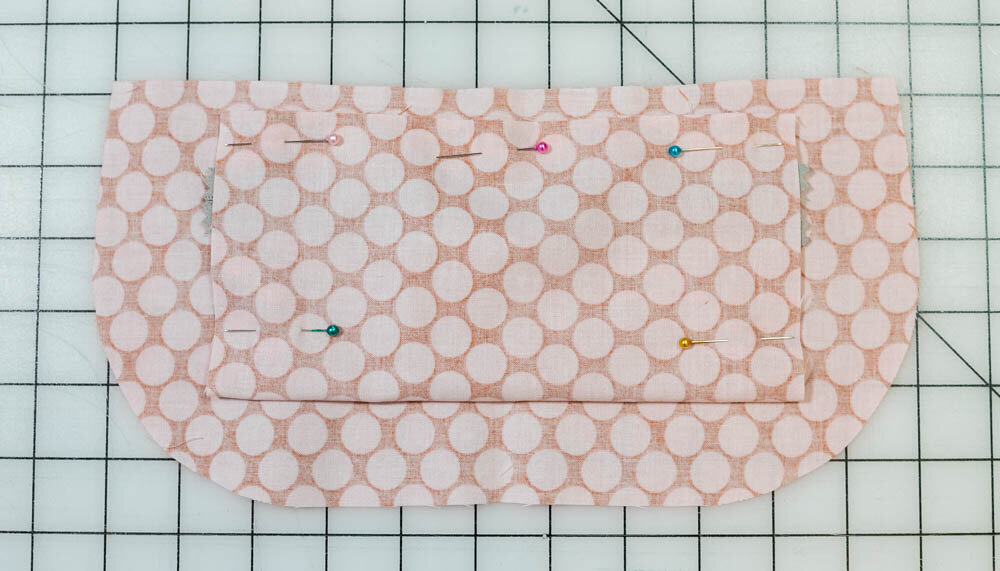
8. Fold up the pocket piece and pin around the top and sides.
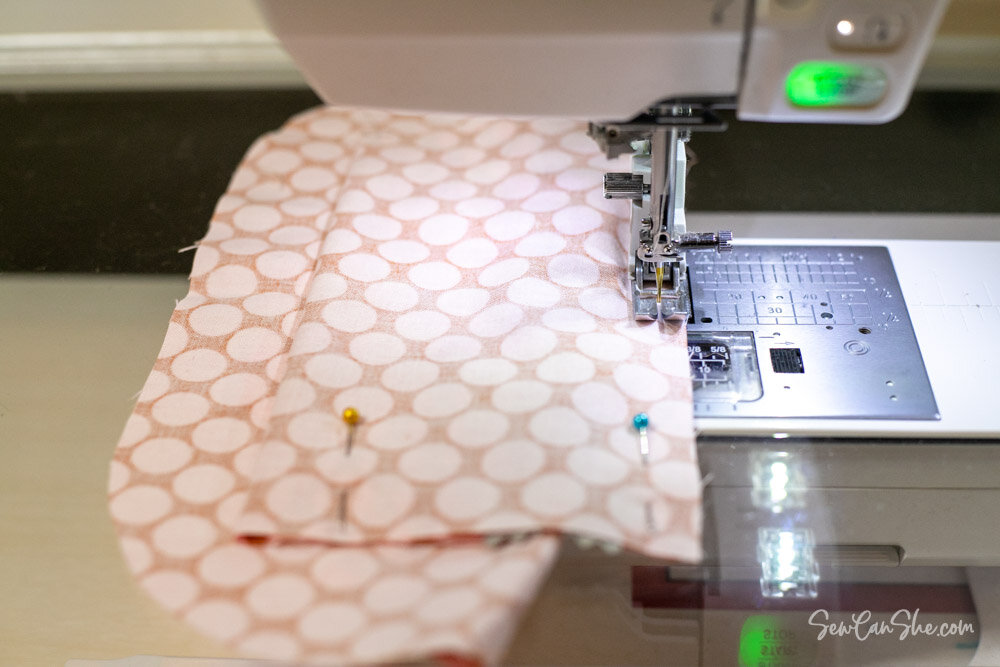
9. Stitch around the pocket top and sides with a 1/4'' seam allowance. If the zipper tapes extend past the edges of the pocket, trim them away.
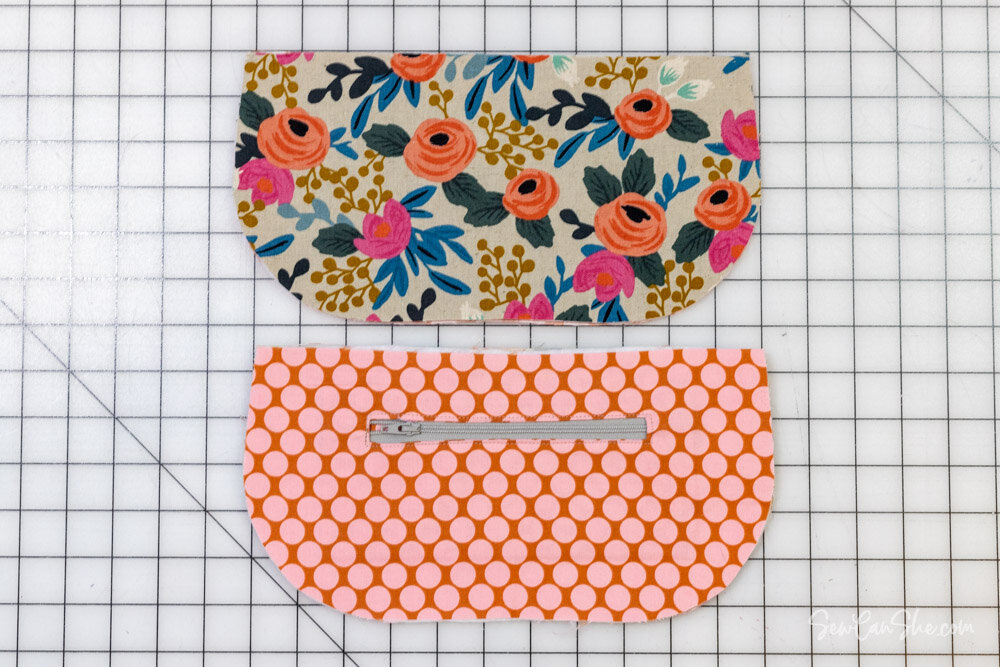
Attach the Zipper
1. Use quilt basting spray to make the purse sides:
Adhere a purse exterior side piece to a matching felt piece.
Then adhere a lining side piece to the other side of the felt. You will have a ‘sandwich’ of lining, felt, and exterior fabric, similar to the gusset.
Repeat to adhere the remaining purse exterior side piece to a felt piece and the other lining side piece.

2. Place one of the side pieces on your workspace, with the exterior side up.
Then lay the 12’’ long handbag zipper on top, facing down. If you are using a piece of Zipper By the Yard, install the zipper pull beforehand.
Pin or use wonderclips to secure the zipper to the top edge of the bag side. The zipper should be face down and extend out 1/2’’ on either side.
Note: This zipper technique is shown in my Designer Zipper Bags video course, Lesson 2.
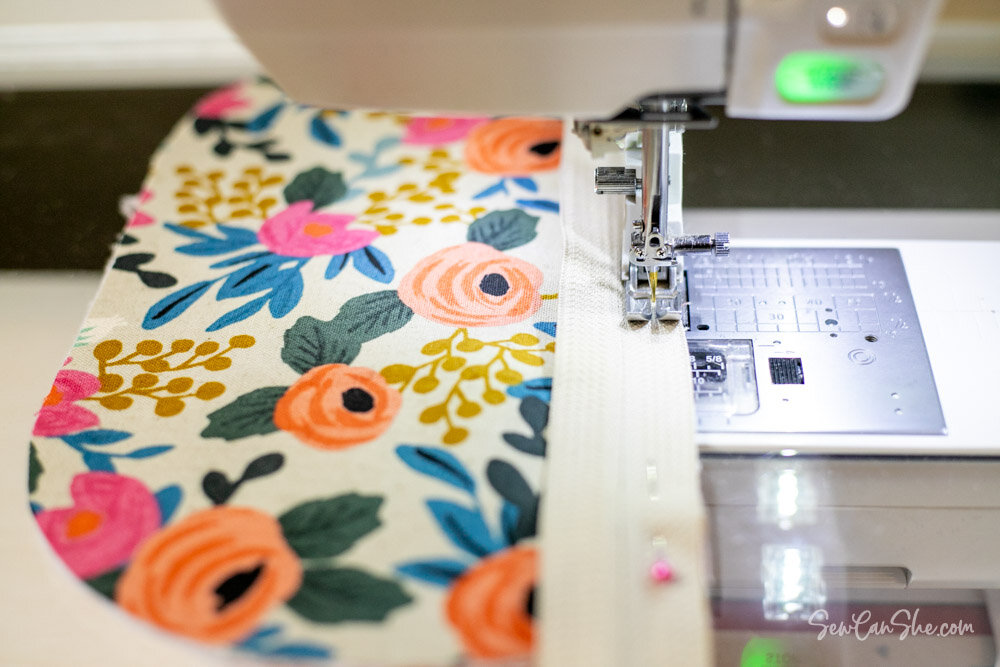
3. Sew the zipper to the top edge with a 1/4’’ seam allowance. Use the zipper foot on your sewing machine if it helps you sew a straight line.

4. Turn the piece over. Carefully trim away 1/8’’ of fabric and felt behind the zipper tape. Do not cut the zipper tape, just the fabric and felt behind it.
Double curved embroidery scissors work wonderfully for this but small sharp scissors work fine too.

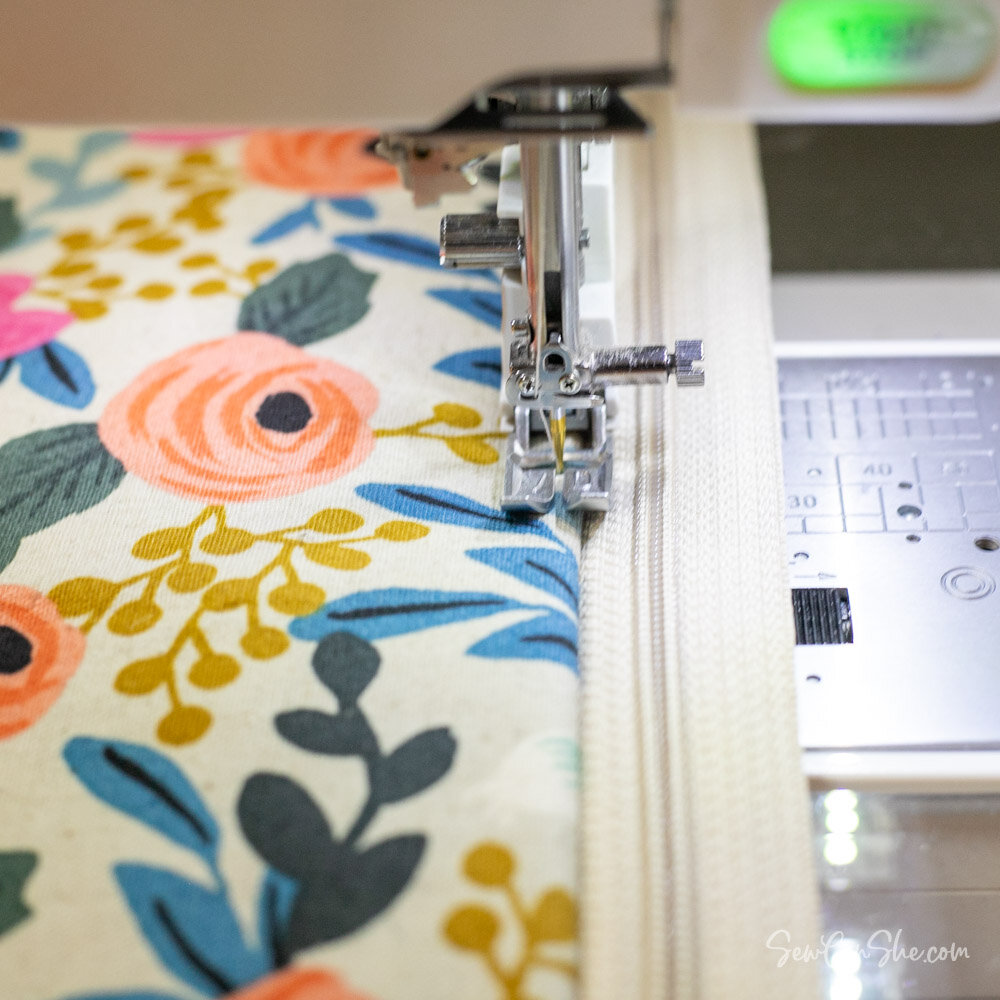
5. Finger press the zipper tape flat against the lining, covering the trimmed seam allowance.
Turn the piece over and topstitch on the fabric 1/8’’ away from the zipper. Check underneath occasionally to make sure that the zipper tape is being sewn flat against the lining.
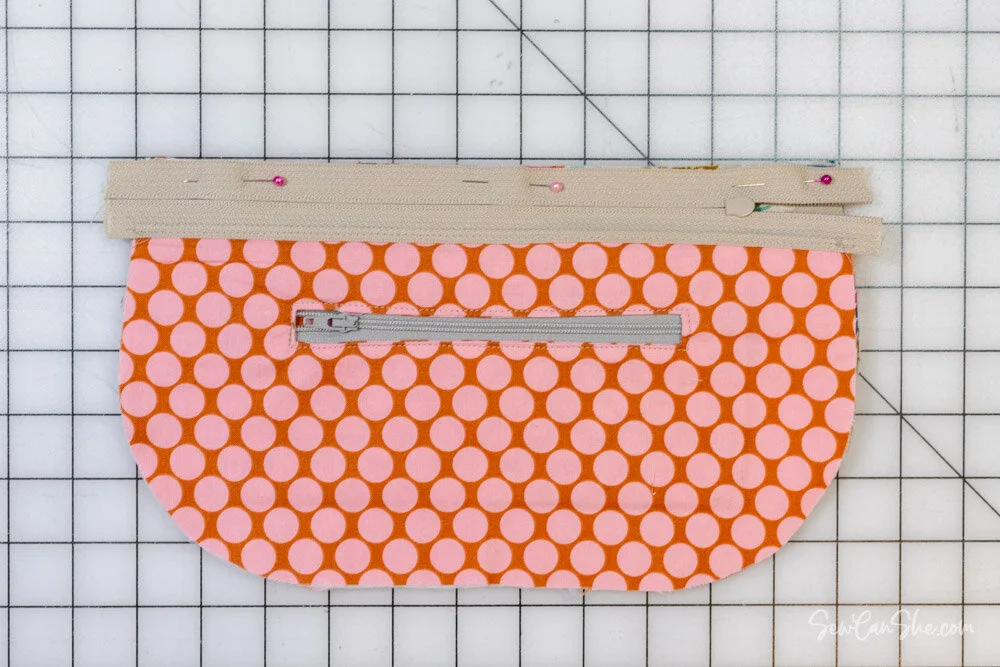
6. Place the remaining side piece on your workspace, with the exterior side up.
Then lay the first piece on top, facing down. The two bag side piece should be right sides together.
Pin the unsewn zipper tape to the top edge of the bag piece underneath.
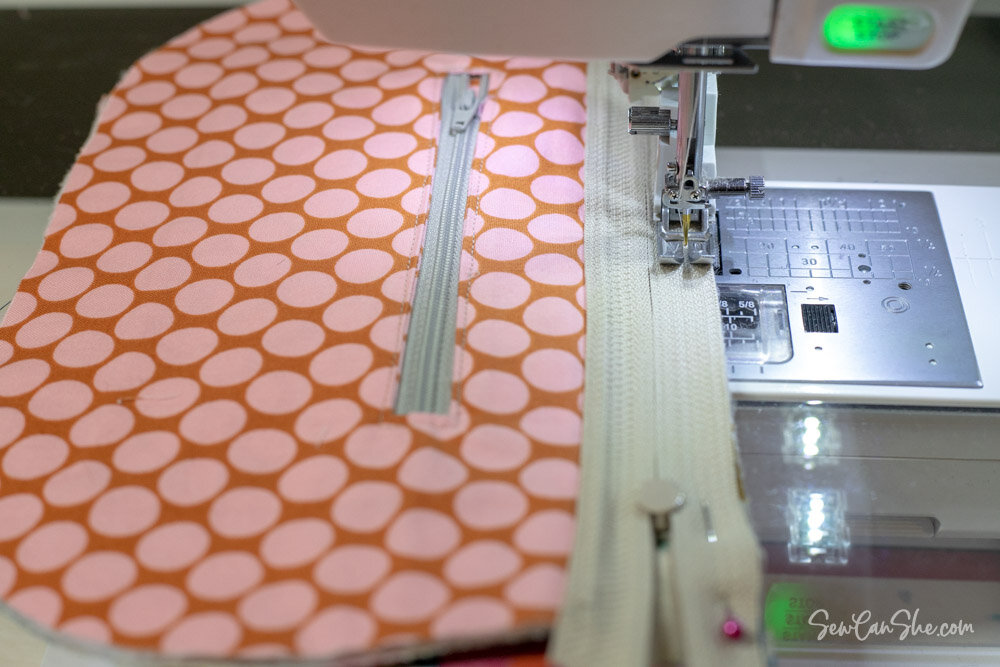
7. Sew with a 1/4’’ seam allowance.
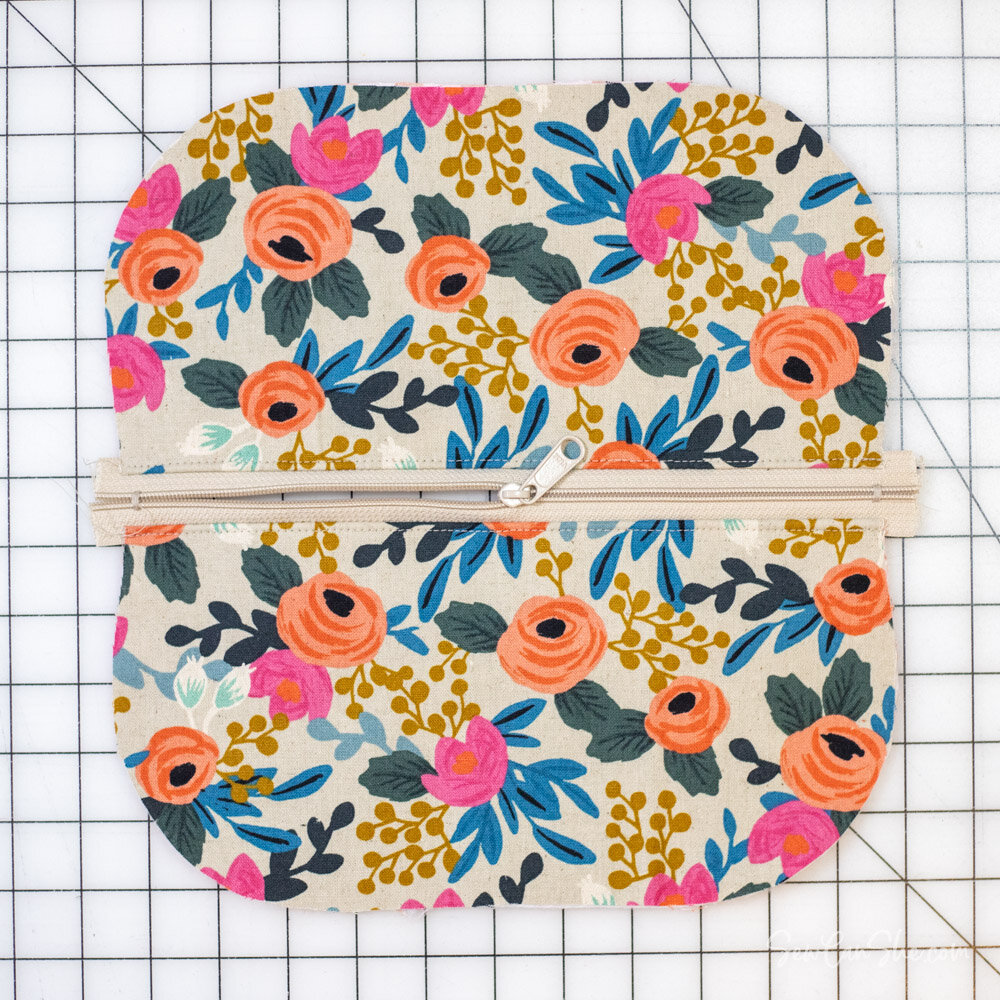
8. Carefully trim away 1/8’’ of fabric and felt behind the zipper tape, as before. Then topstitch on the fabric 1/8’’ away from the zipper, catching the zipper tape underneath.
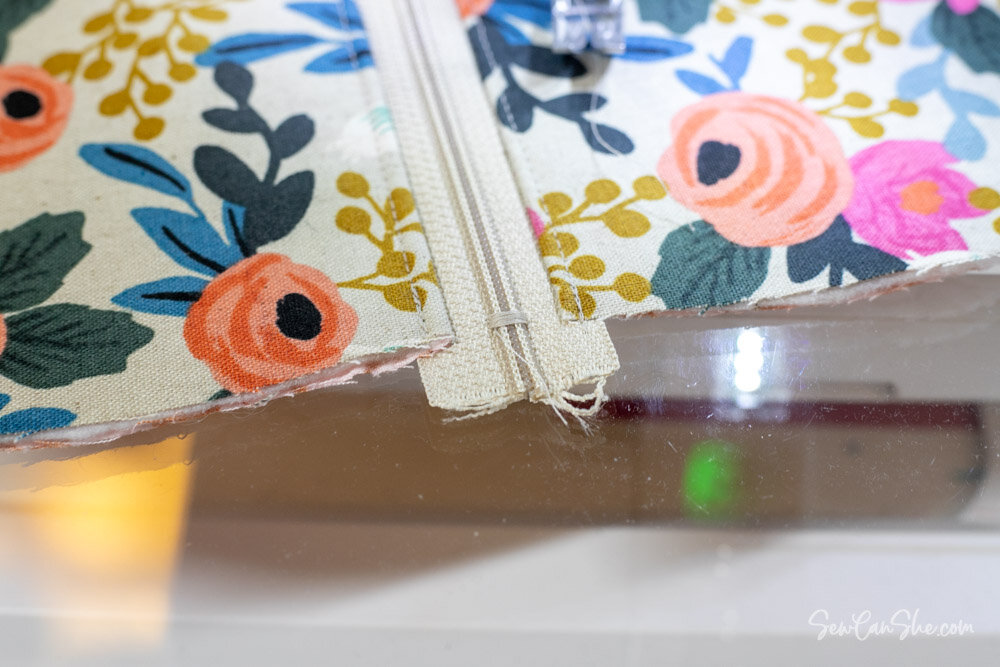
If needed, sew across the zipper teeth at either end of the zipper to make ‘stoppers’ and prevent the zipper pull from accidentally coming off.

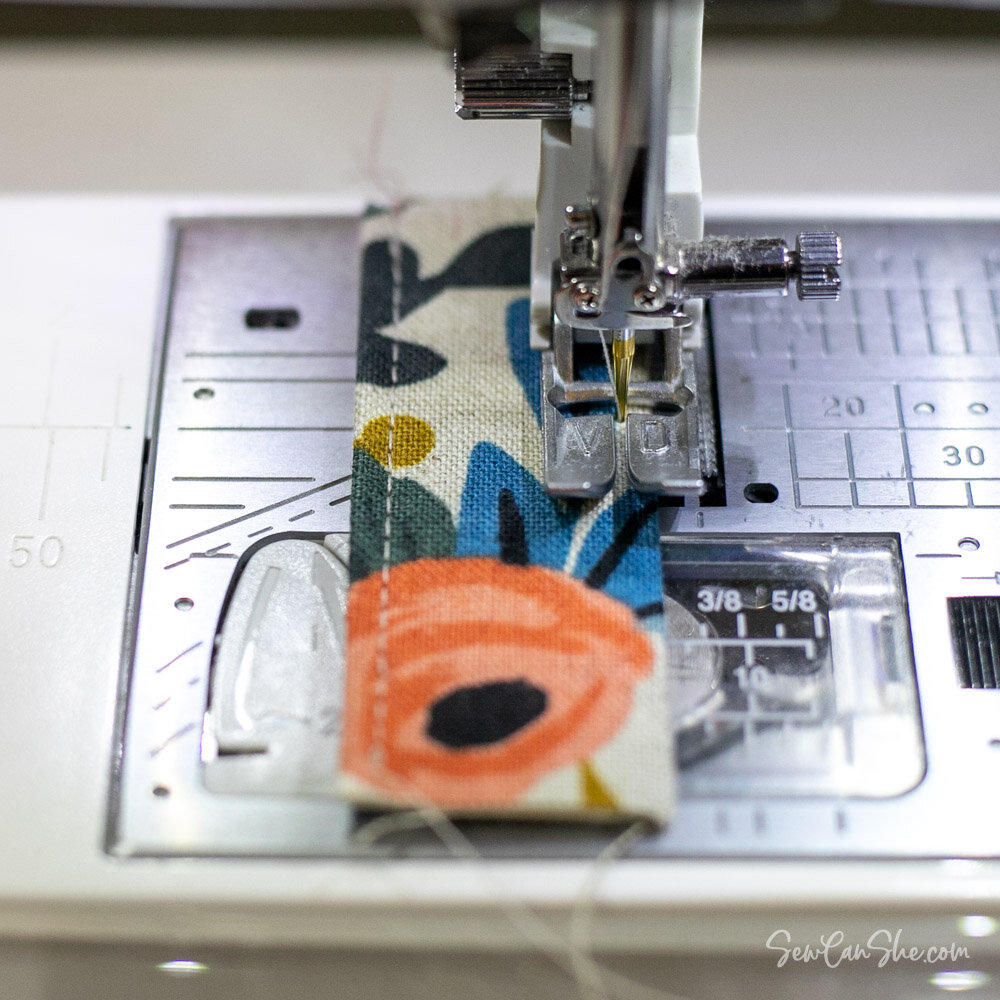
Make the Ring Tabs
1. Fold the 3’’ x 4’’ tab pieces in half with the 3’’ edges together and press. Then open them and press the long edges to the fold. Fold in half again and press to make 1’’ x 3’’ tab pieces.
2. Topstitch along each piece 1/8’’ away from the long edges.
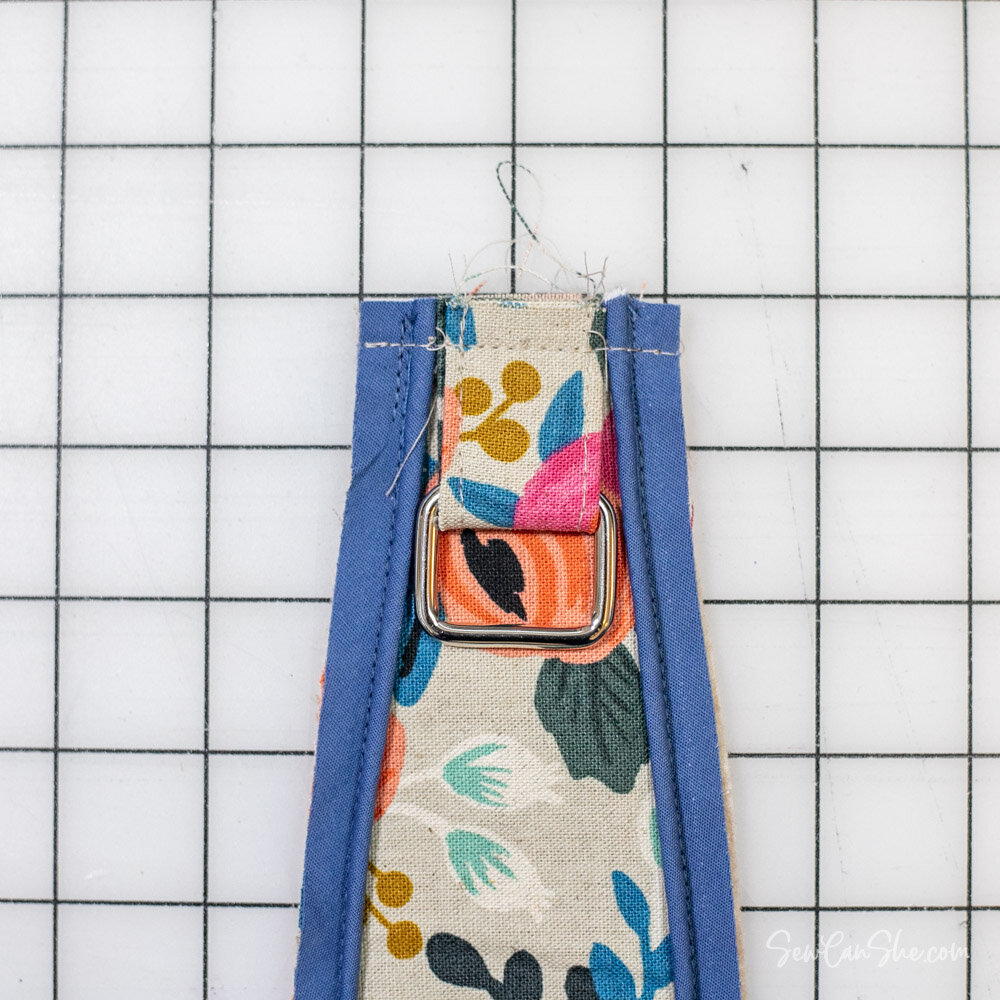

3. Insert one tab piece into the rectangle ring and fold the tab in half with the raw ends together. Place the tab at one end of the gusset in between the piping with the raw edges all lined up.
Stitch across the end of the gusset with a 1/4’’ seam allowance to secure the tab in place.
Tip: as you stitch across the end of the gusset, make sure that the ridges of piping are folded toward the inside. If you stitch them down this way, it will prevent them from folding outward and looking awkward later.
Repeat to insert the second tab piece into the d-ring and sew it to the opposite end of the gusset in the same way.
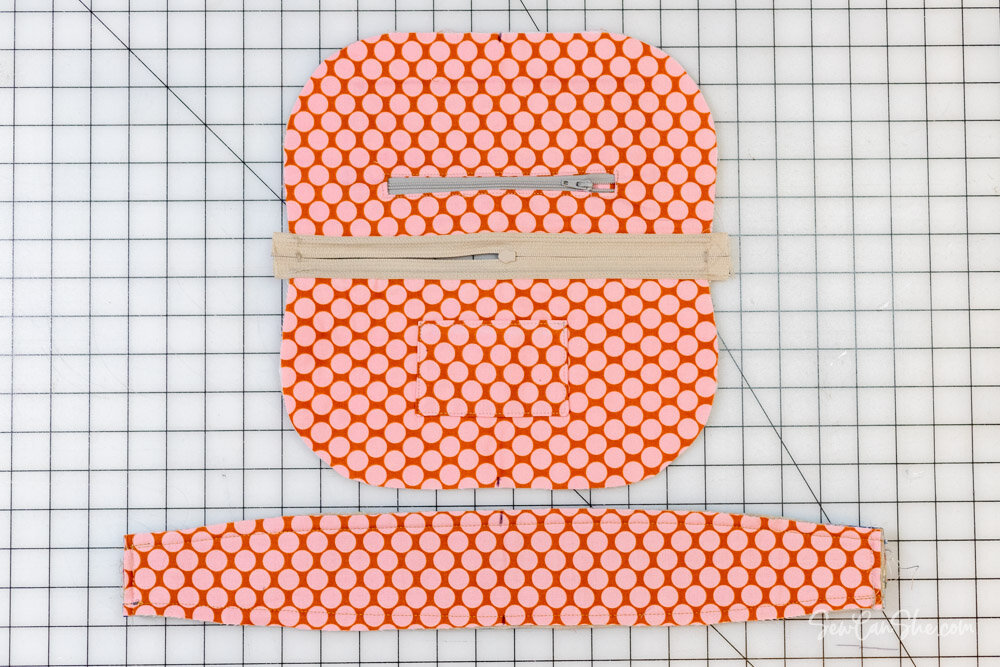
Assemble the Baguette Bag
1. Use a pencil or fabric marker to make the following marks on the lining side of the bag pieces:
Mark the center at the bottom of each side piece
Mark the center of each gusset long edge
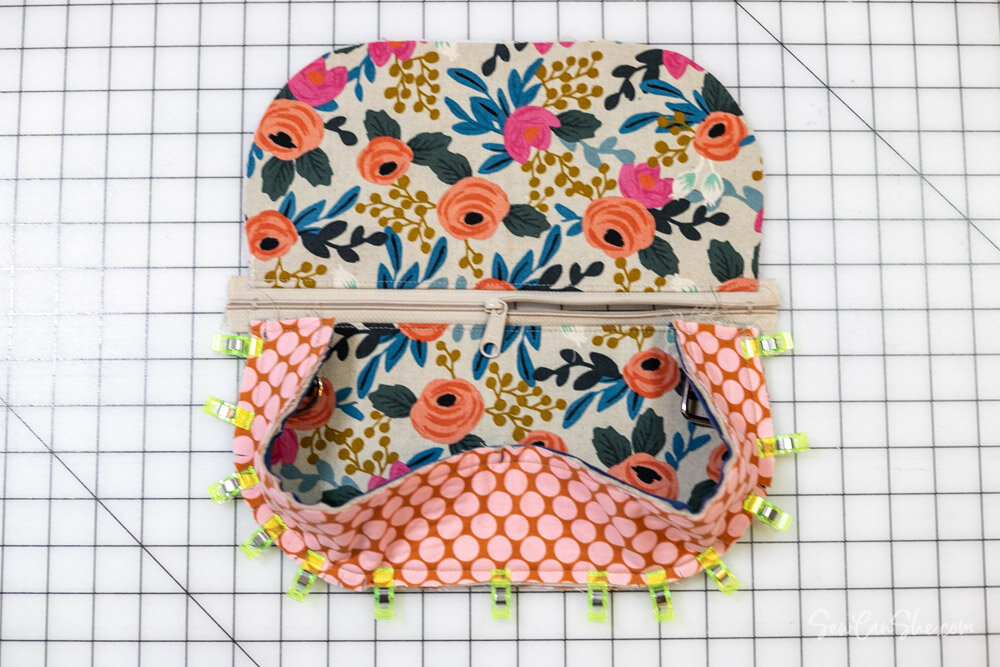
2. Use wonder clips to secure the gusset to one side of the bag with right sides (exterior sides) together. The lines up just below the zipper on one side and extends around to just below the zipper at the other side.
Match the center mark on the gusset to the center mark at the bottom of the bag side.
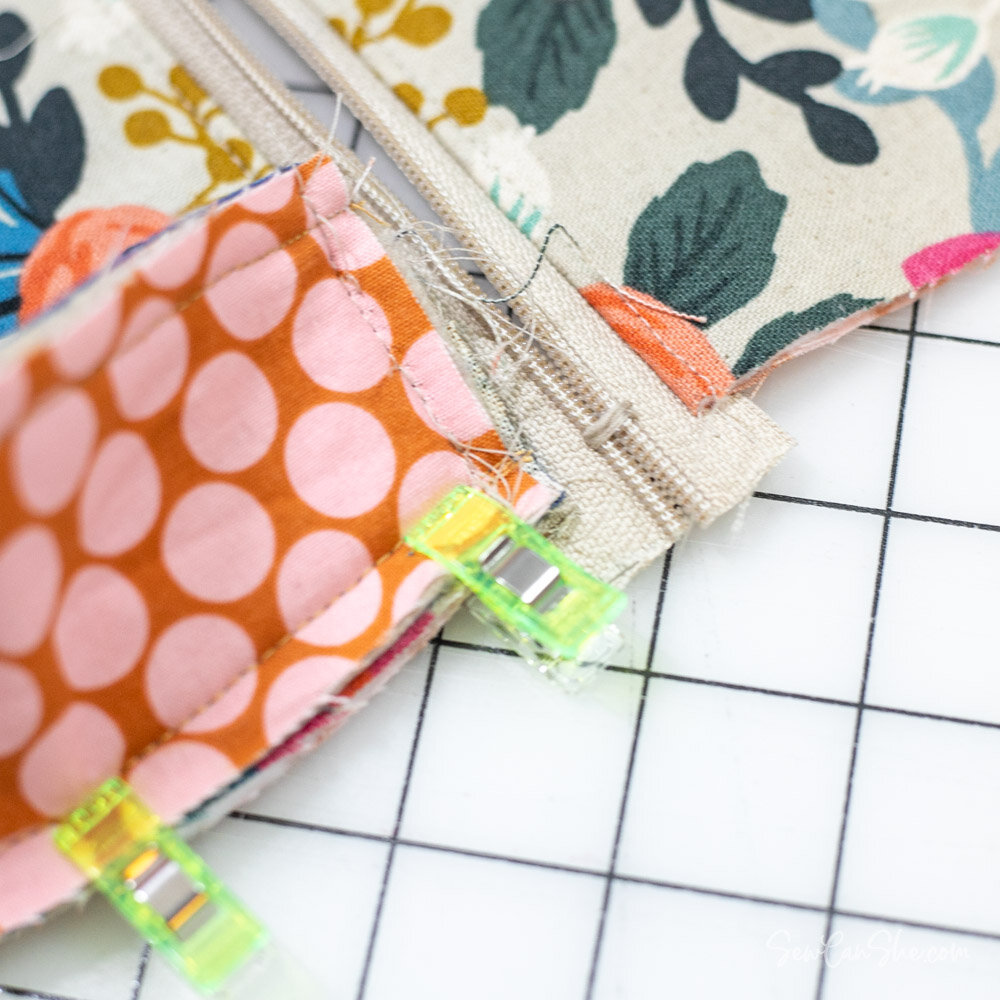
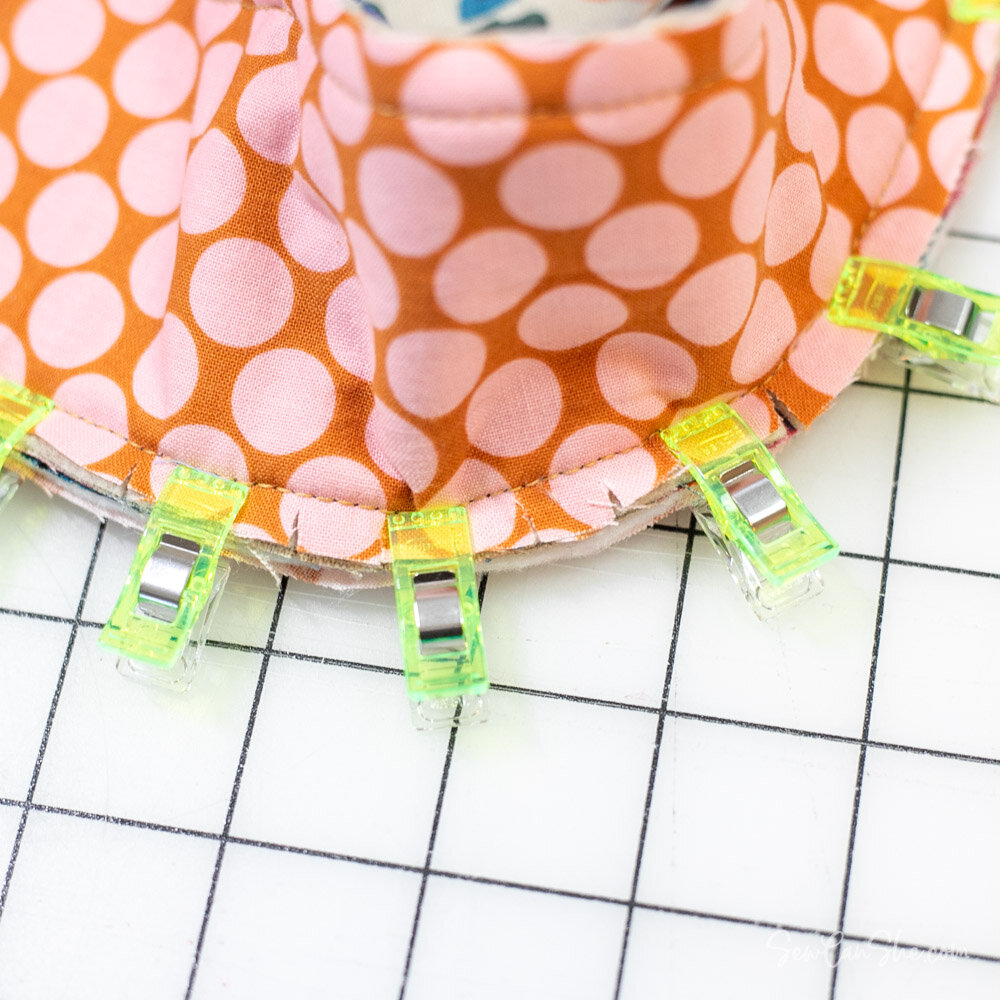
Important: The short end of the gusset should line up with the topstitched edge of the bag side. It should not extend onto the zipper. The gusset should not be sewn to the zipper.
Cut notches into the gusset seam allowance to help it curve around the corners of the bag. You may cut notches all the way to the stitching for the piping. It helps to cut notches at least every 1/2’’ all the way around the curve.
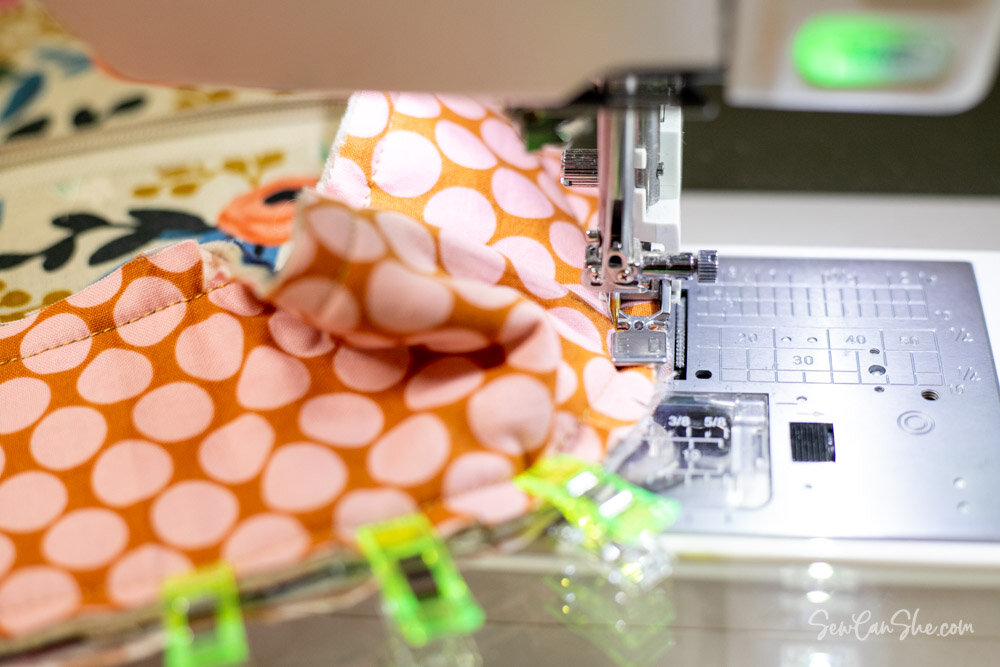
3. Sew the long edge of the gusset to the bag side, starting just below the zipper on one side and ending just below the zipper at the other side.
Tips:
Sew with the gusset facing up so you can stitch right on top of the stitching that attached the piping.
Use a zipper foot to help you sew as close to the piping as possible. You may be able to sew just to the left of your previous line of stitching so you are sewing even closer to the piping. A tight seam with piping looks amazing, but don’t sew over the piping.
If you did not attach piping to the gusset, this seam should be sewn with a 3/8’’ seam allowance.

Turn the bag right side out to quickly check the seam with the piping. I’m sure it looks fabulous!

4. Place the bag right sides together and clip the other long edge of the gusset to the opposite side of the bag. Match the center mark on the gusset with the center mark at the bottom of the bag side.
Tip: Make sure the zipper is 1/2 way open.
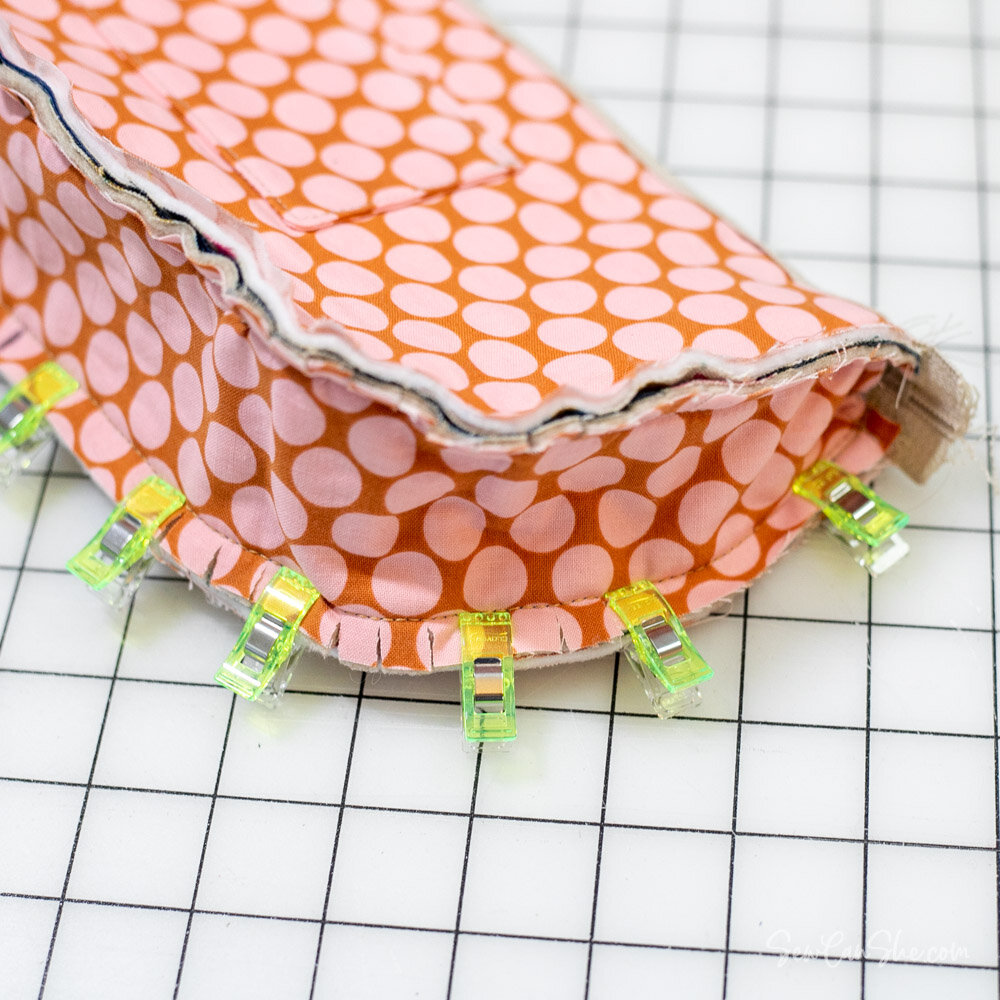
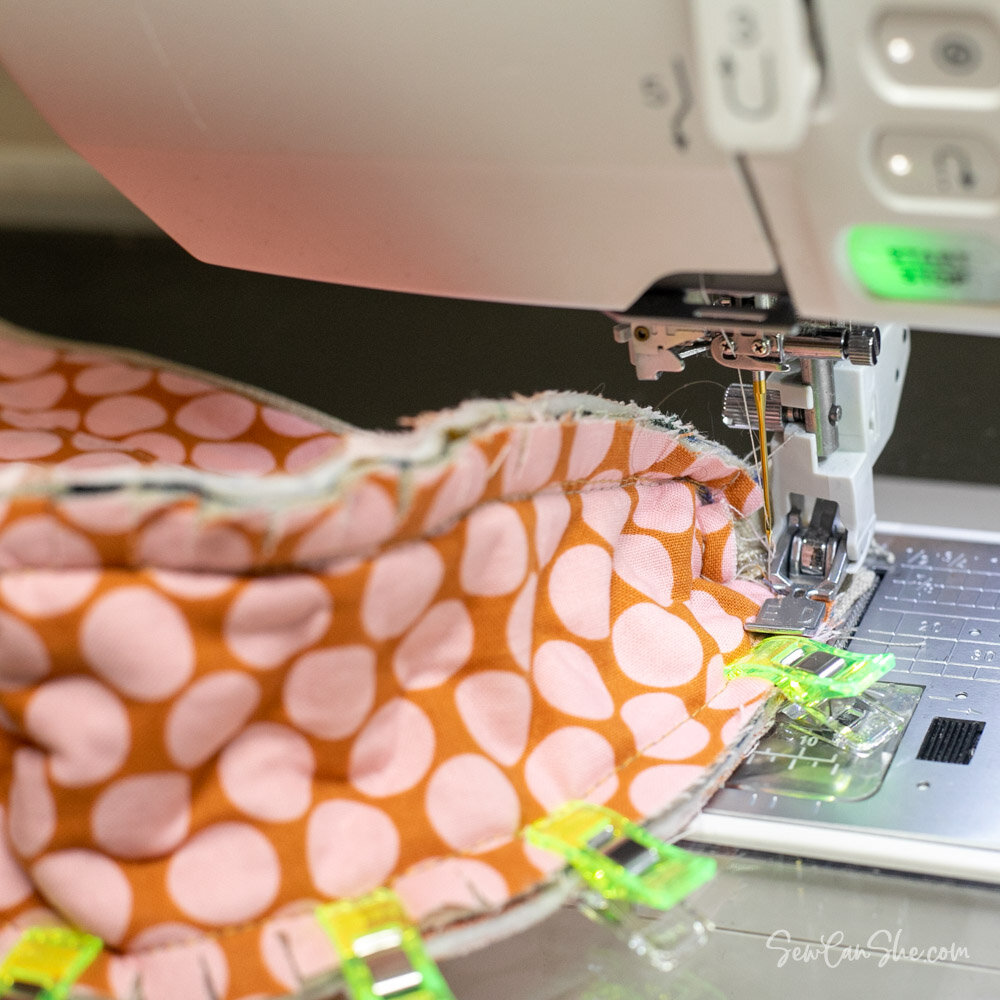
As before, place the short ends of the gusset just below the zipper at either side of the bag. Cut notches into the gusset to help it curve around the corners.
Stitch the remaining long seam as before.
It is tricky to begin and end sewing in such a tight spot. I found it very helpful to use my zipper foot and try to sew exactly on top of the previous stitches (that attached the piping).
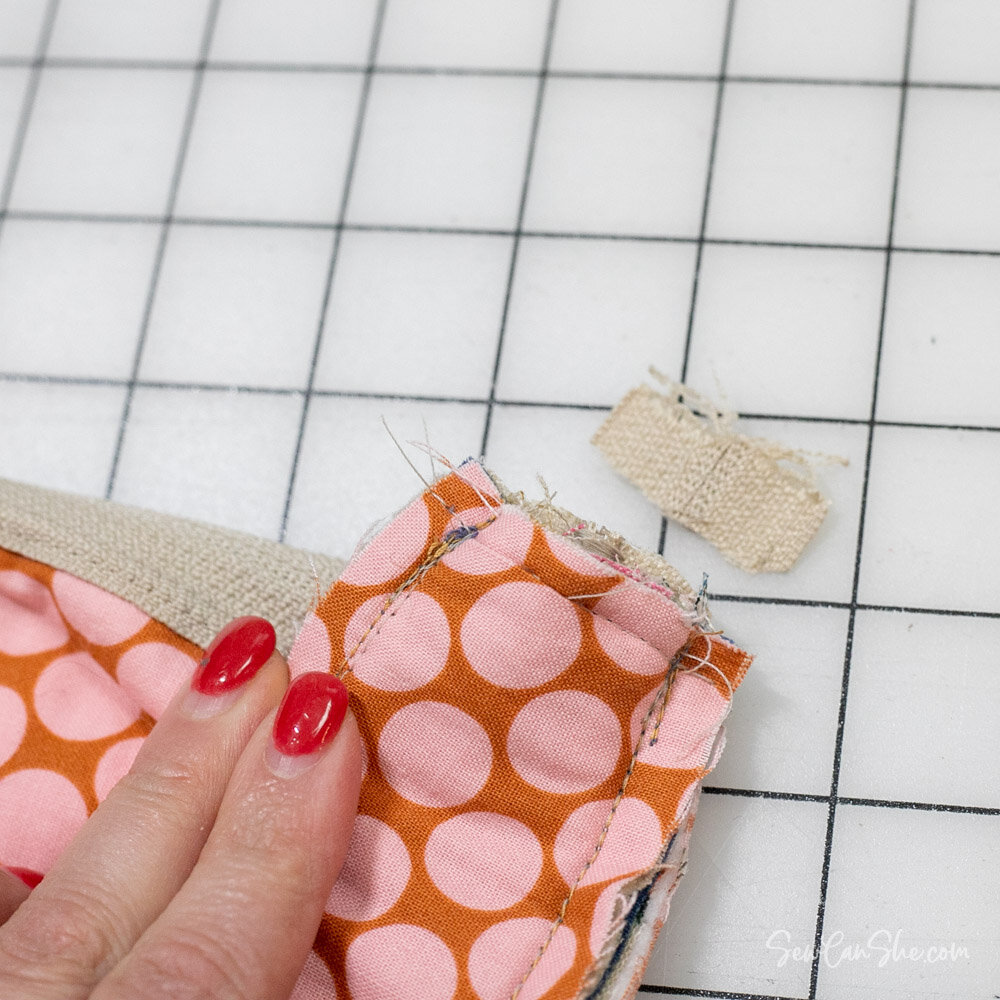
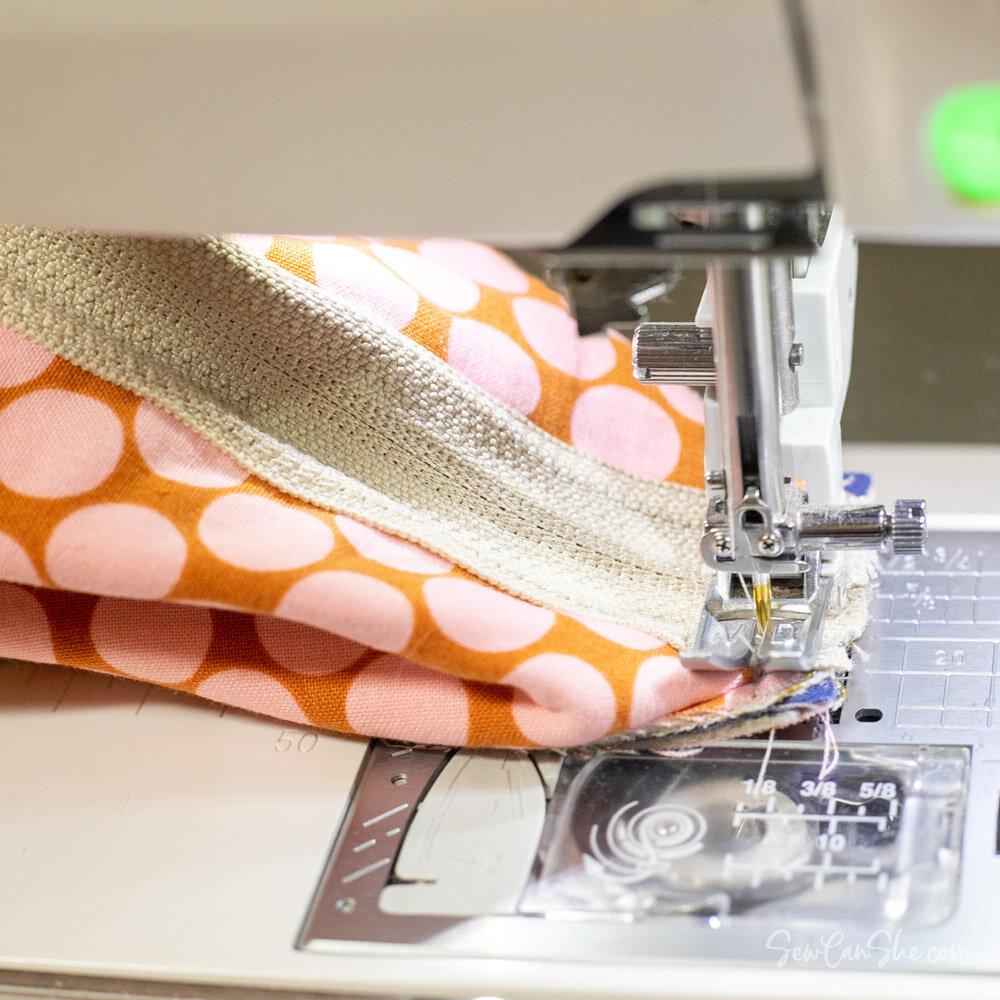
5. With the bag still inside out, flatten the top end of the gusset at one side of the bag against the end of the zipper. This can be a bit fussy, so work with the bag and smooth out the short end of the gusset until it lays flat against the end of the zipper.
Trim away the extra bit of zipper so that the zipper end and gusset end line up.
Sew across the end of the zipper and gusset with a 3/8’’ seam allowance.
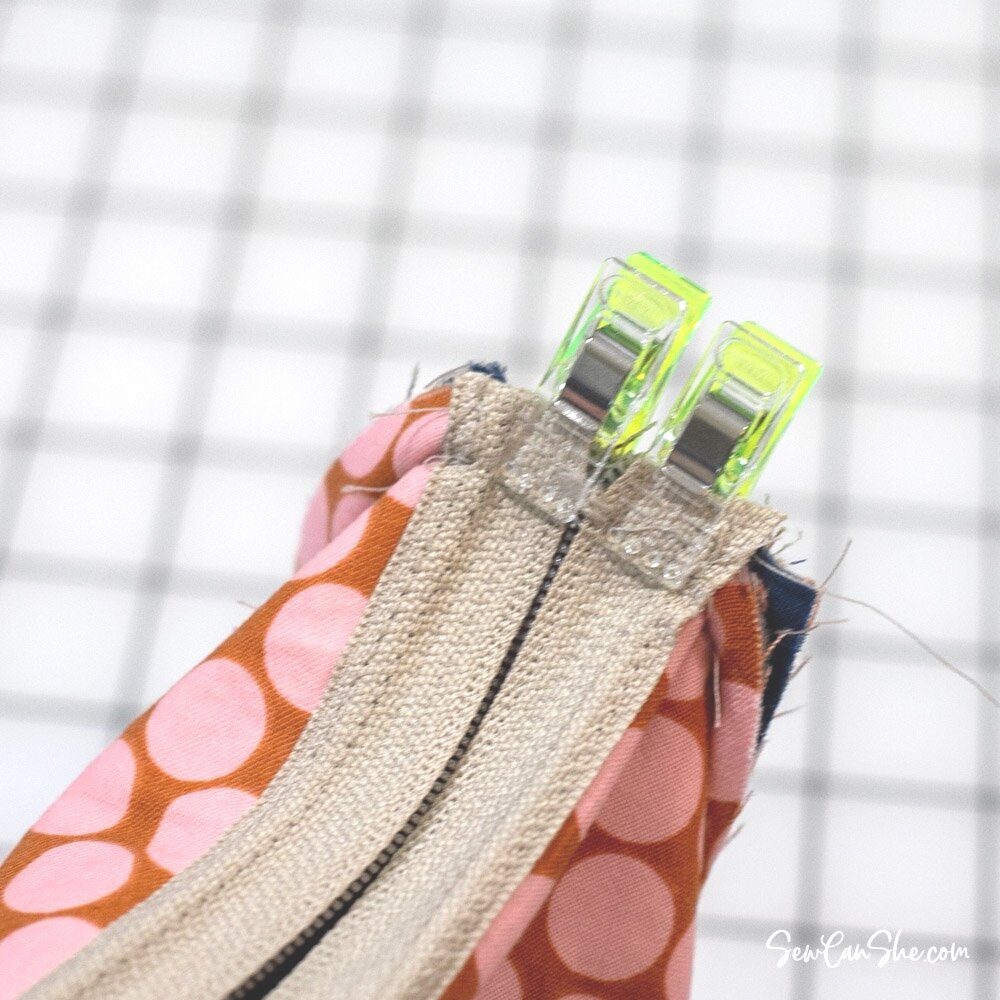

Repeat this step to trim the zipper and sew a short seam at the other end of the bag.
At the end of the bag where the zipper tapes may be open, you can use wonder clips to help secure the two zipper tapes to the short end of the gusset before you sew.
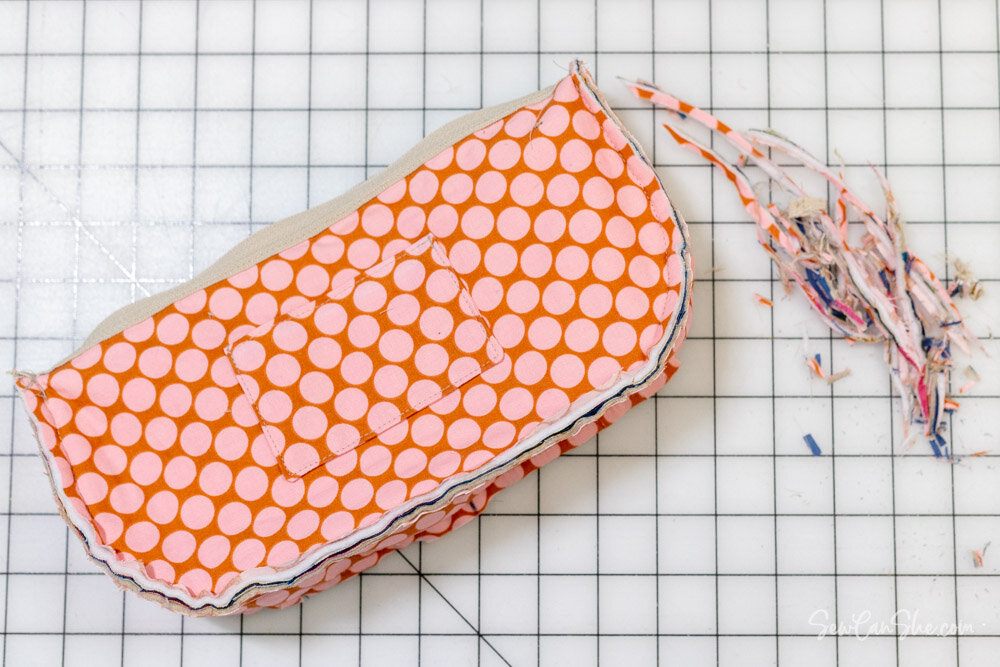
Bind the Inside Seams
If you are not already using a heavy duty needle (size 100/16 suggested), switch to one now. Sewing on the binding requires sewing through thick layers.
1. Trim 1/8’’ away from all of the inside seams to remove bulk and leave only 1/4’’ seam allowances.
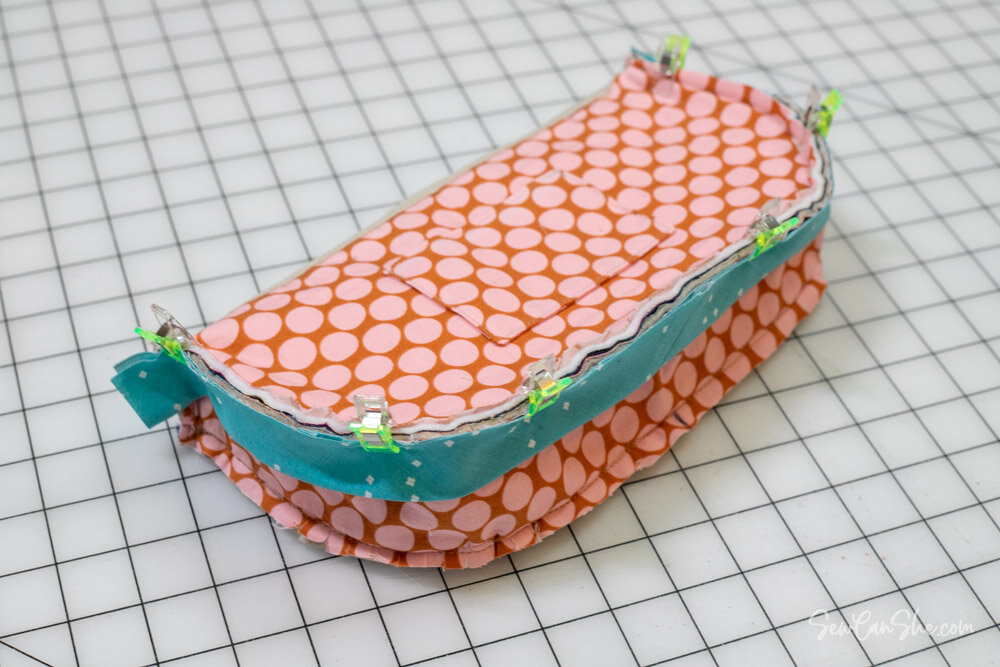
2. Fold the 2 1/2’’ x 20’’ bias binding strips in half lengthwise and press.
Clip one binding strip to a long seam, lining up all the raw edges.
You may sew the binding to either side of the seam. I found it easiest to start by sewing the binding to the gusset side of the seam.
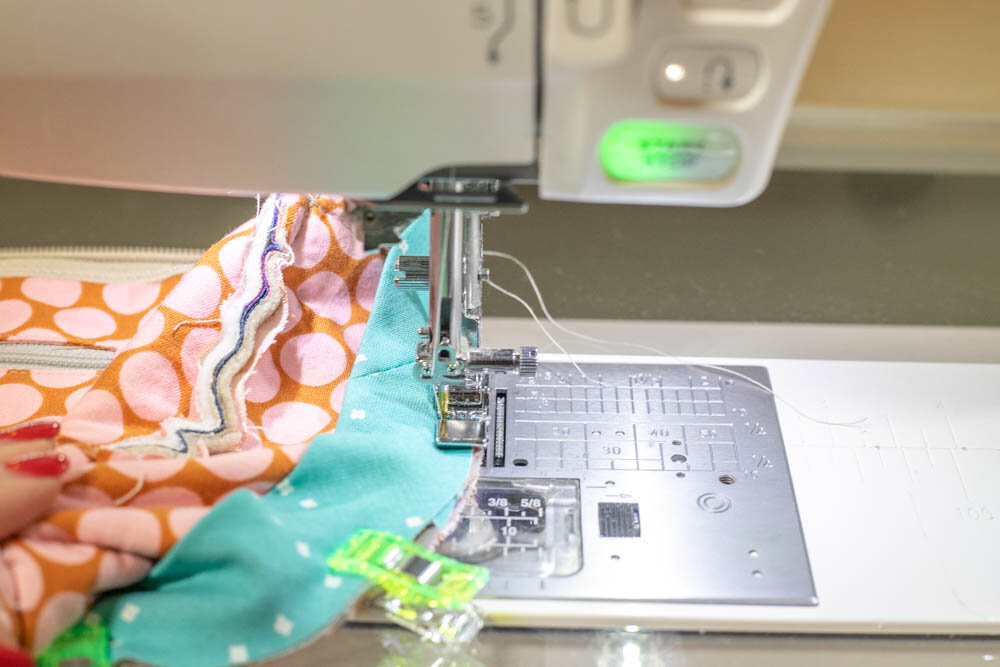
3. Sew the binding to the seam with a 1/4’’ seam allowance.
Once again, I found it easier to sew with the zipper foot attached to my sewing machine so I could ‘feel’ where the piping was located inside the seam.
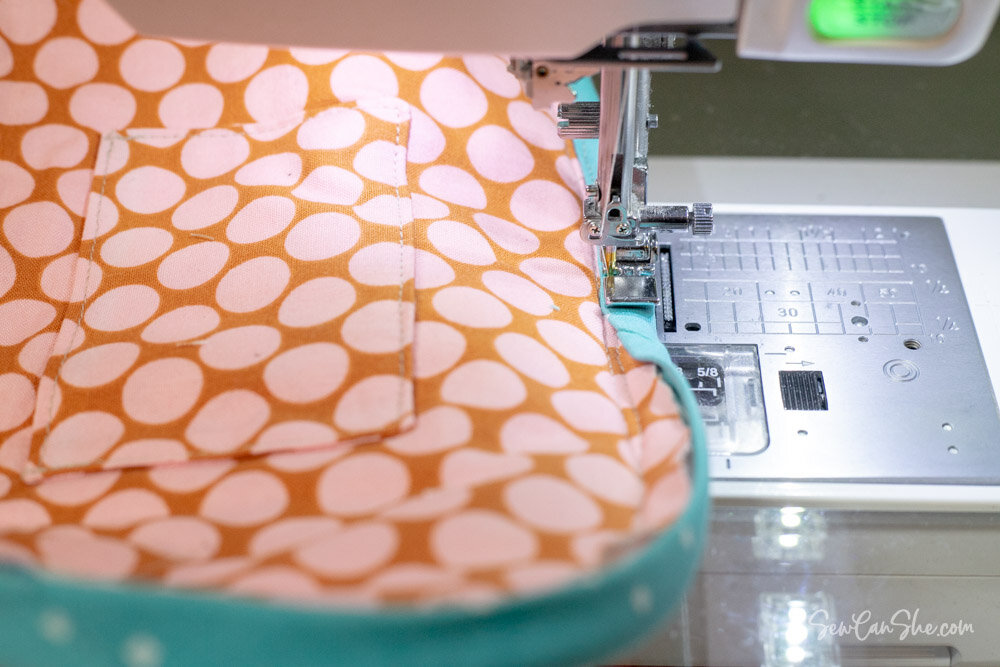
4. Turn the folded edge of the binding around to the other side of the seam and sew it down close to the fold.

Repeat to bind the other long seam with the remaining 2 1/2’’ x 20’’ bias binding piece. Cut away the extra binding at the ends.
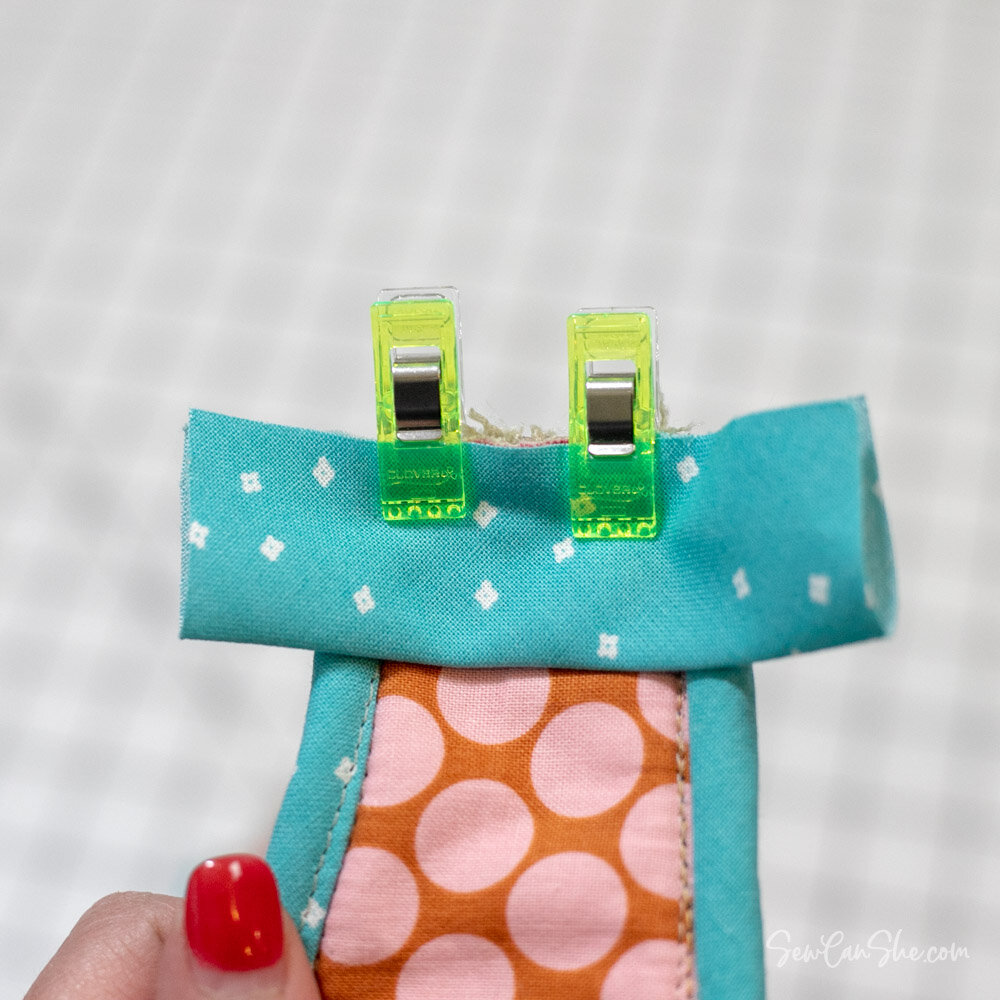
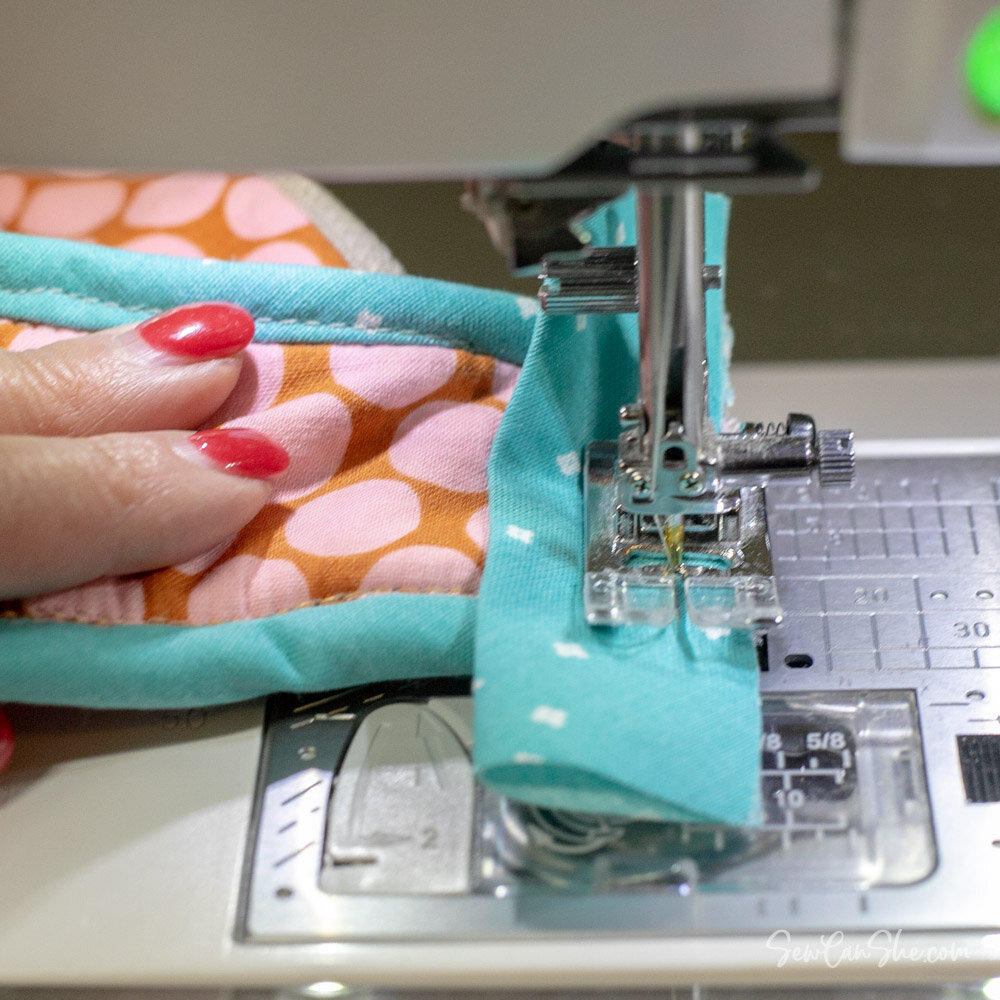
5. Fold the two 2 1/2’’ x 3 1/2’’ binding pieces in half lengthwise (with the 3 1/2’’ edges together) and press.
Center one short binding piece against one end of the bag and pin or clip in place.
Sew with a 1/4’’ seam allowance.
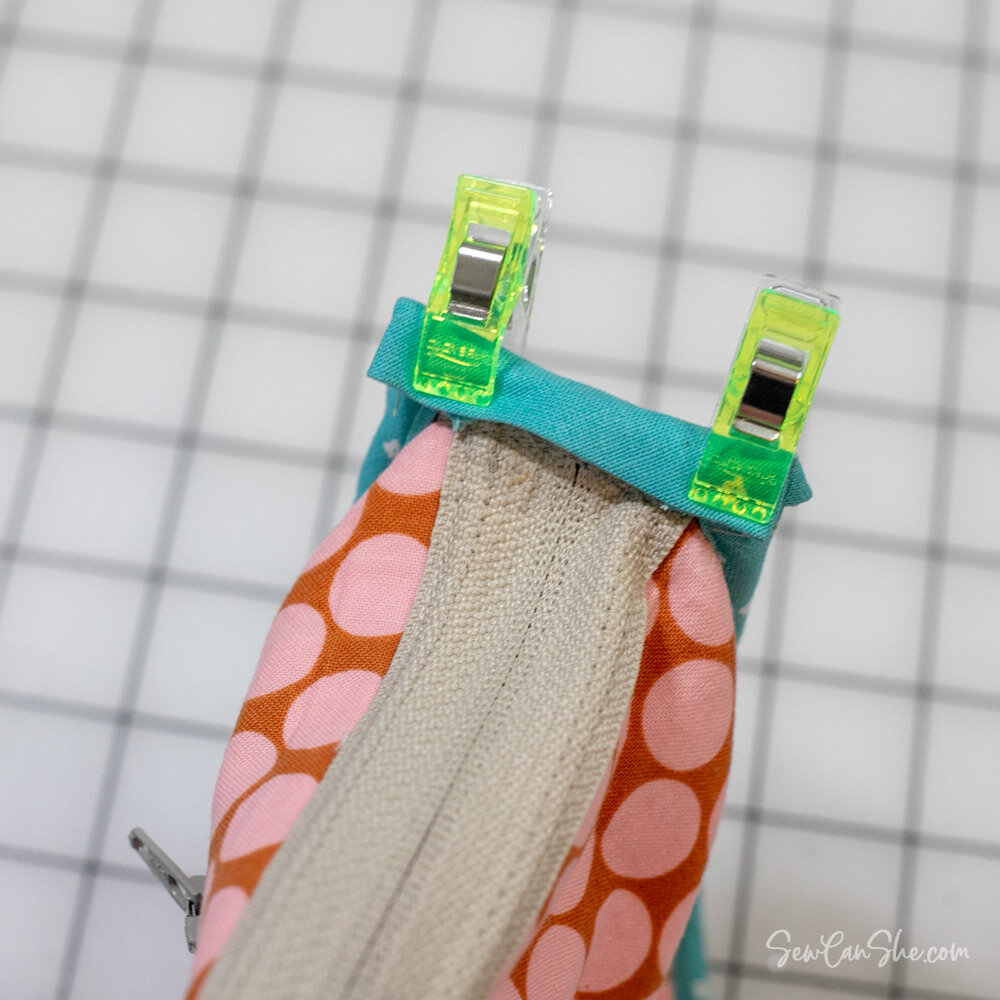
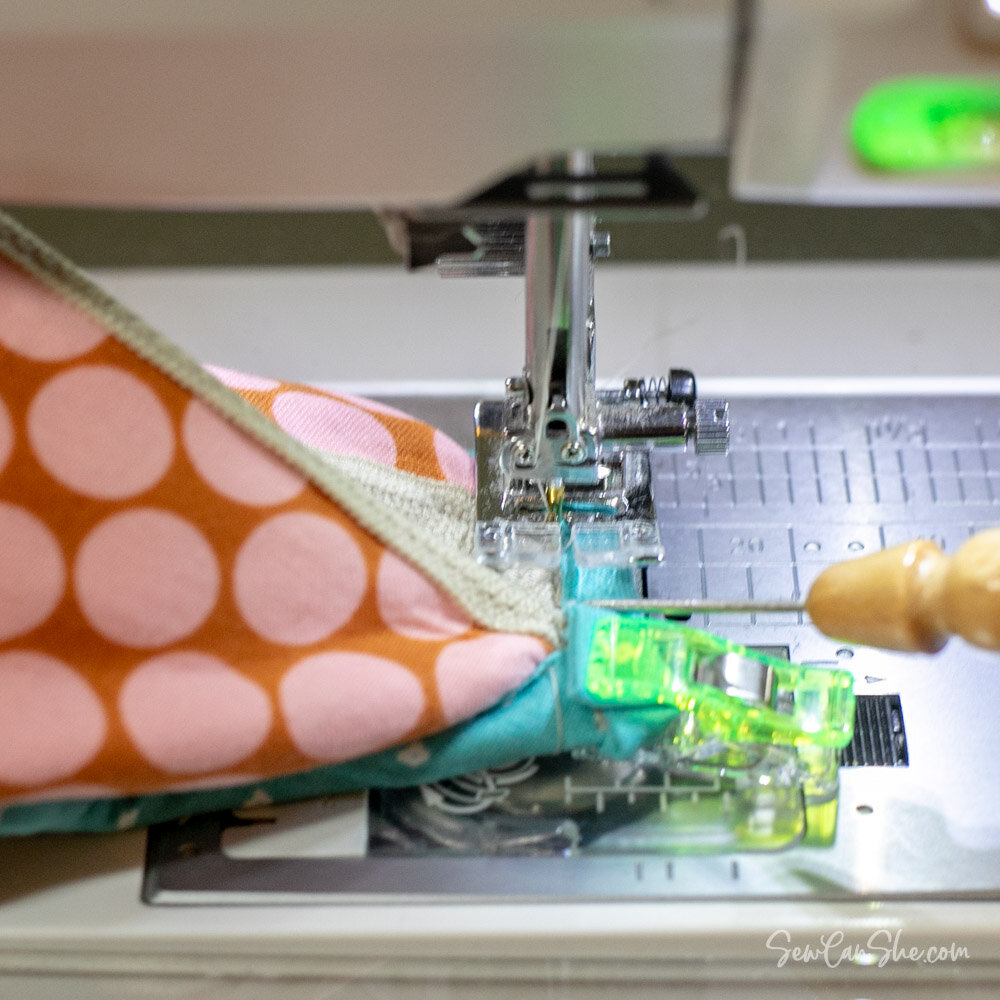
6. Fold the ends of the binding around first and then wrap the folded edge over, tucking the ends under for a neat finish. Clip in place.
Stitch the binding down close to the fold. In the photo above right I’m using my sewing stiletto to help hold the binding as I sew. I love that tool!
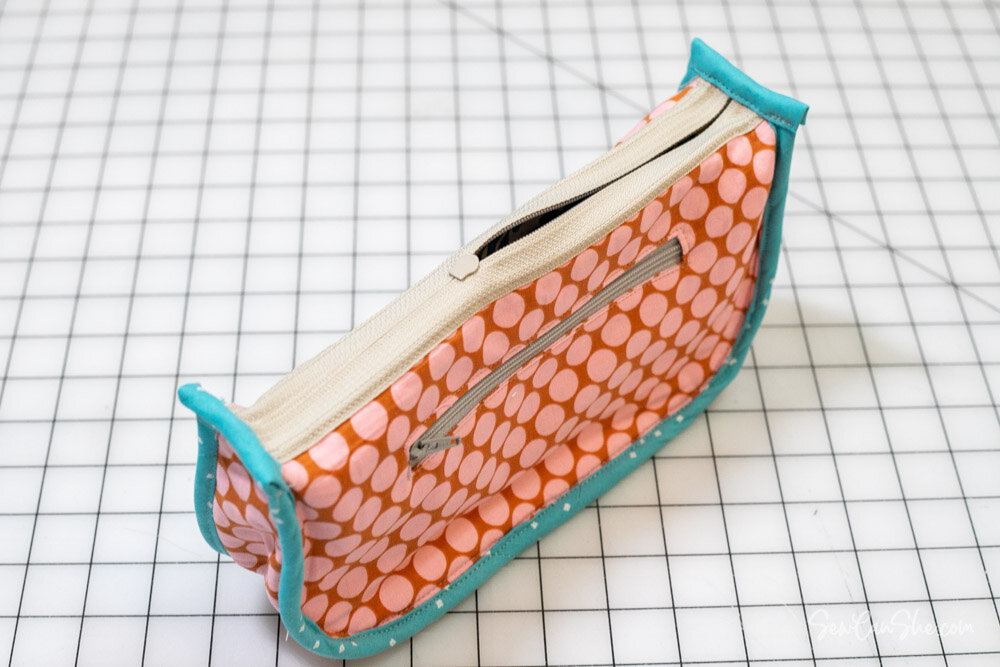
Repeat to bind the seam on the other end of the bag.
Tip: I show all of these binding techniques in my free Designer Zipper Bags video course, Lessons 3.3 and 3.5.
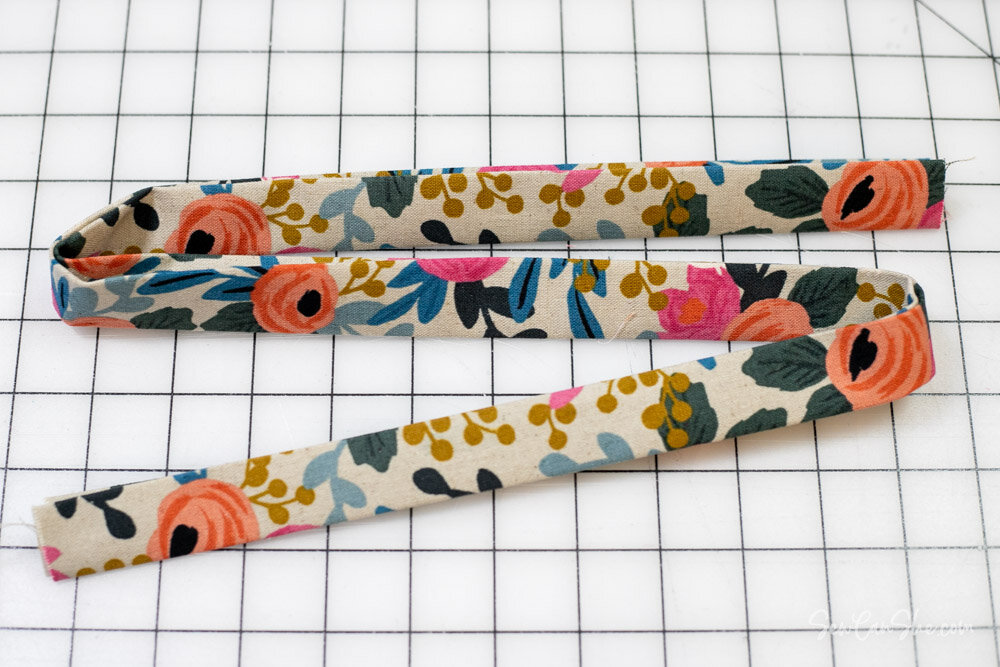
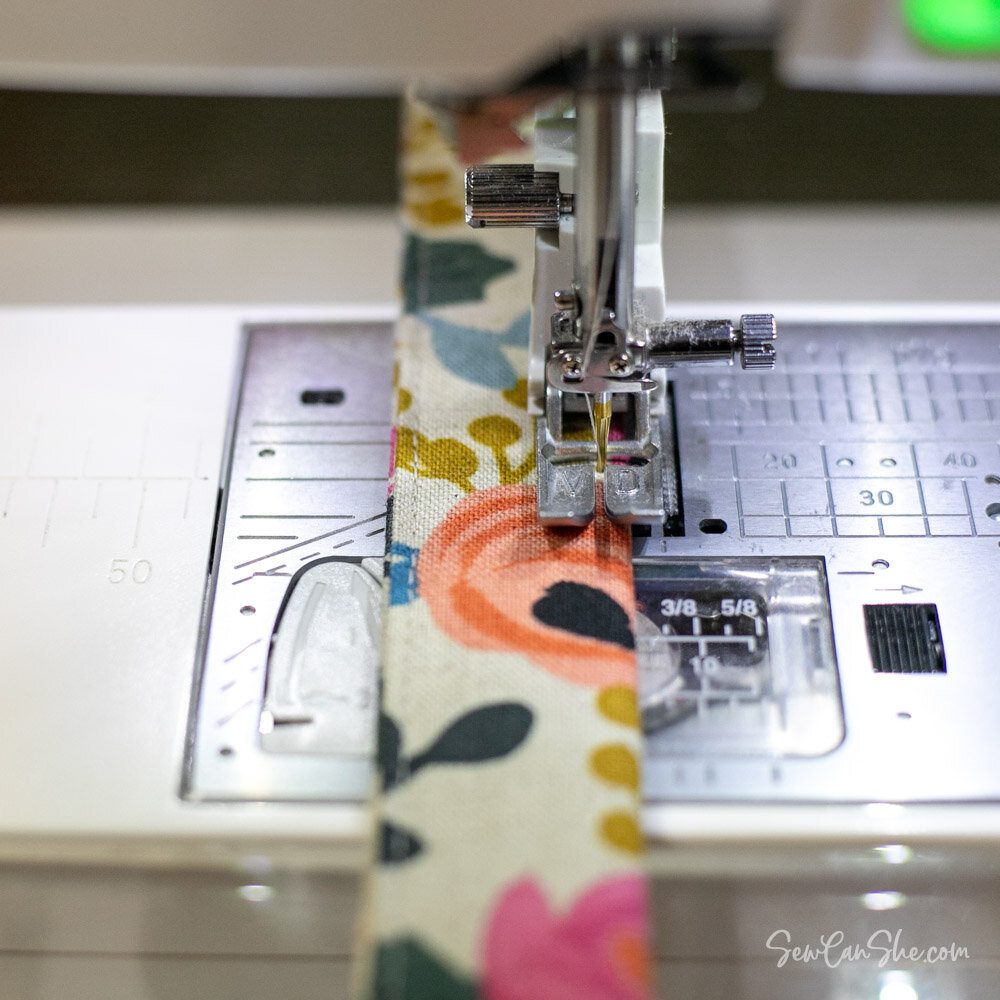
Make the Adjustable Purse Strap
1. Fold the 4’’ x 35’’ strap rectangle in half lengthwise and press. Open and fold the long edges to the center, press. Fold in half again and press to make a 1’’ x 35’’ long strap.
2. Topstitch along both long edges, 1/8’’ from the edge.
Tip: A walking foot (or even feed foot) for your sewing machine can make it easier to sew long straps without waviness or puckering.

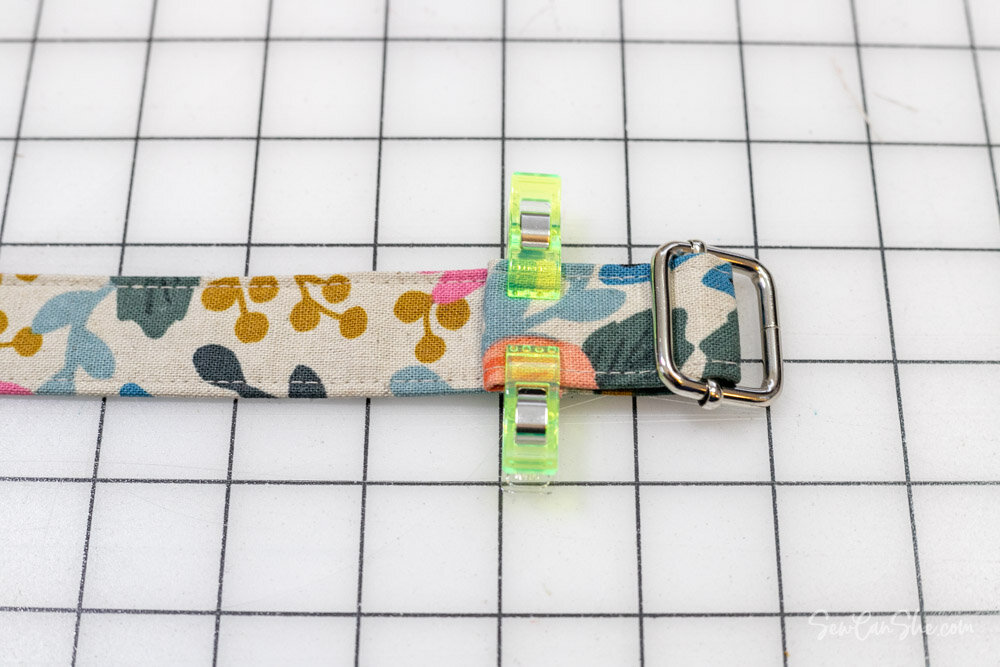
3. To make this strap adjustable, slide the triglide slider onto one end. Move it until it is about 2’’ from the end of the strap.
Turn the strap over and fold the end of the strap onto itself. Tuck the raw edge under by 1/2’’. Hold the end in place with clips as you move to the sewing machine.
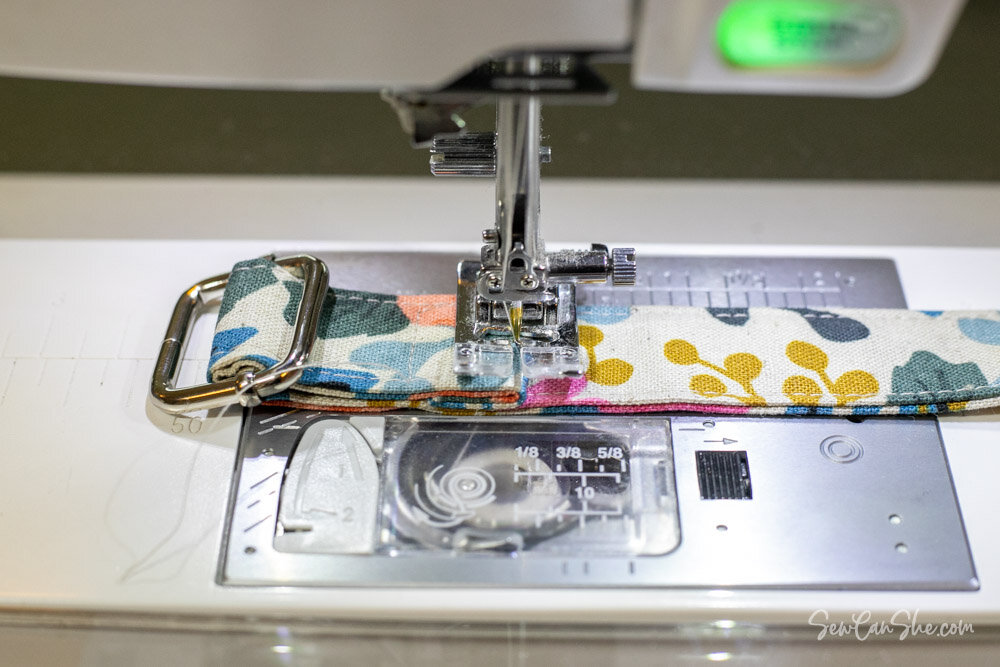
4. Sew a rectangle over the folded end in place. Backstitch to secure (I sewed around my rectangle twice to make it extra secure).
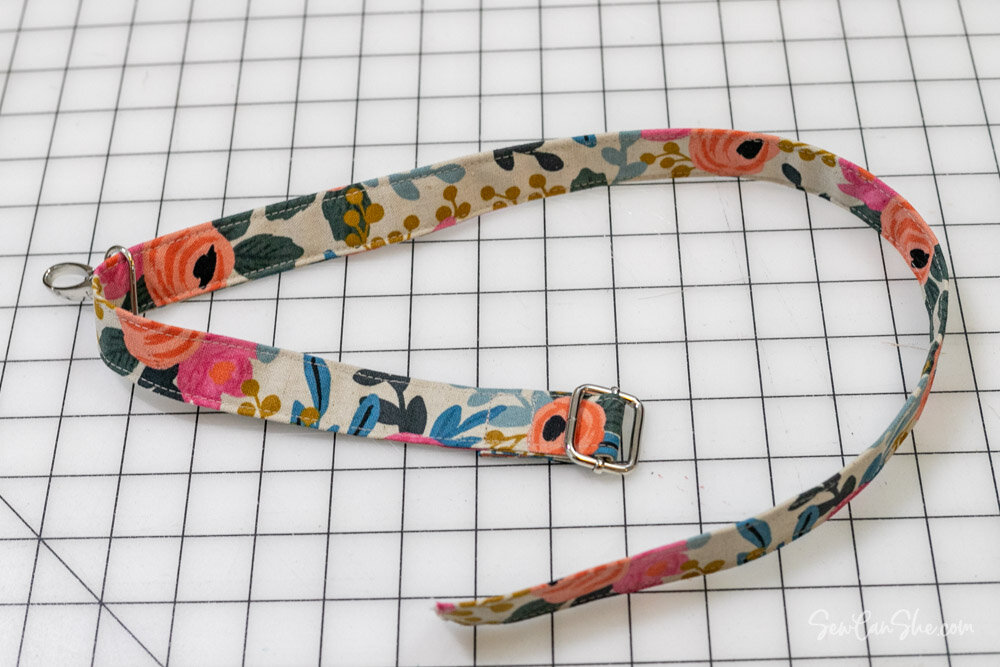
5. Now slide the swivel snap clip onto your strap. Move it down until it is about 8’’ away from the triglide slide.
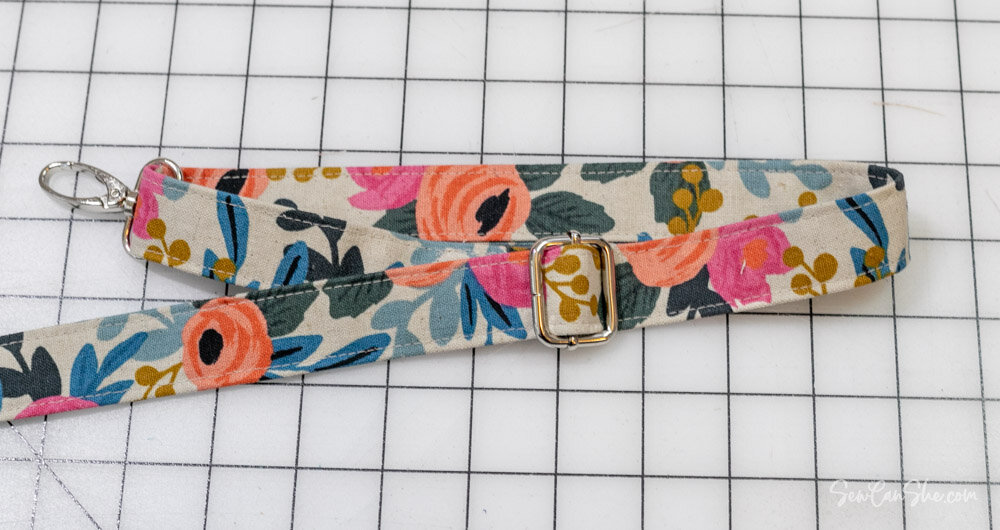
6. Make a loop with the strap and feed the end back through the triglide slide. It might look kind of like a belt now.
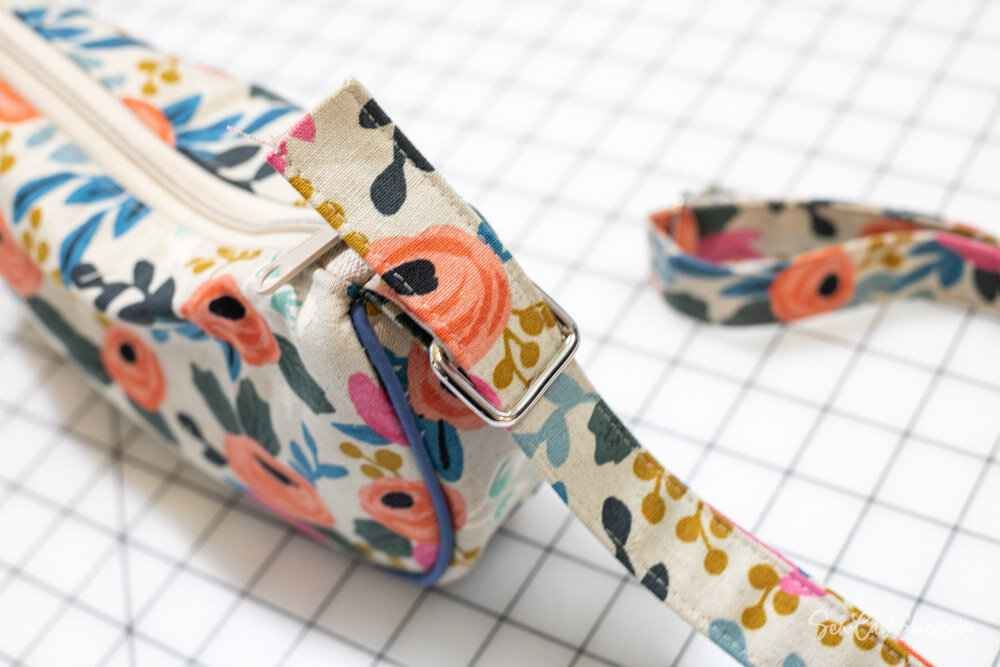
7. Push the free end of the strap upwards through the rectangle ring on one end of the purse.

Fold the strap over on itself and tuck the end under by about 1/2’’. Clip the end to hold it in place as before.
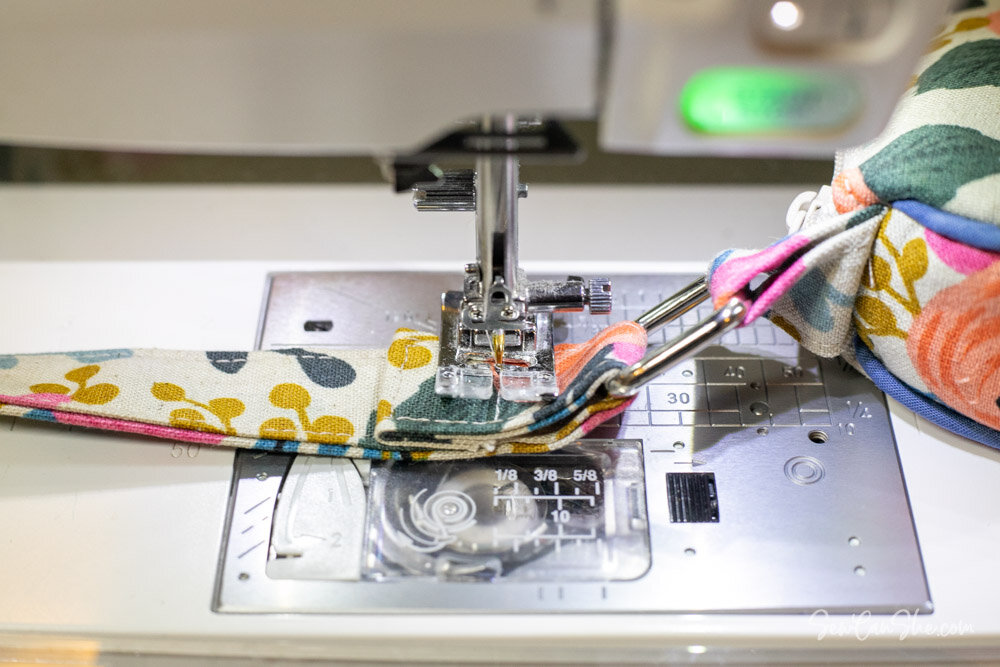
8. Sew a rectangle over the end of the strap to secure it. Consider sewing around your rectangle twice to ensure that it won’t come undone.
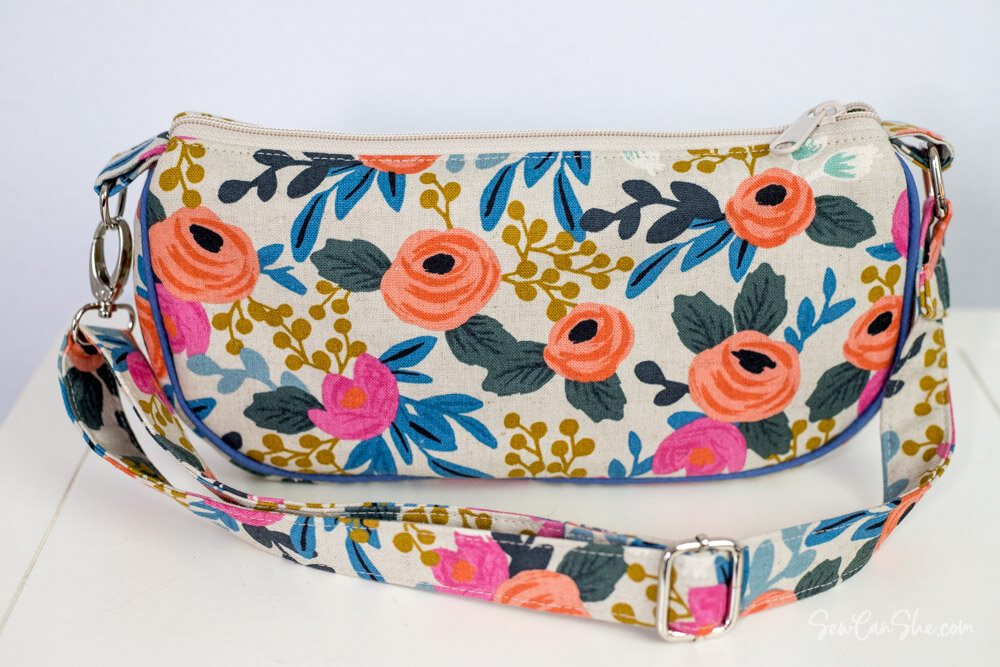
And now your Baguette Bag is finished. I hope you love your new little purse as much as I love mine… I have been taking it with me everywhere ever since I finished it!
This was a really long sewing tutorial! Don’t forget that I also prepared it in PDF format that has been optimized for printing.
As always, I’d love to see the projects you sew from my patterns and tutorials. Please post a picture to Instagram and tag me @sewcanshe or #sewcanshe so I can take a look!
xoxo,


